Travel report: A journey through the Balkans
Last two years I already visited (by airplane) the Balkan countries Montenegro and Albania for a hiking vacation with my girlfriend and a photography trip with my photo buddy Rick. The wild nature of the Balkans attracts me a lot. As the Balkans are not well known yet, and a lot of people from West Europe think its still dangerous there (most area’s are safe nowadays), you can walk around in the mountains without seeing anyone for a whole day.
The Balkan countries also have very nice, often old cities at the Adriatic coast which are touristic, but not nearly as those in e.g. Italy.
Below you can find a few pictures from my trip last year, which convinced me to go back again this year. Most photo’s of this year can be found in high resolution here. The timelapse video my friend Rick made is also worth checking.
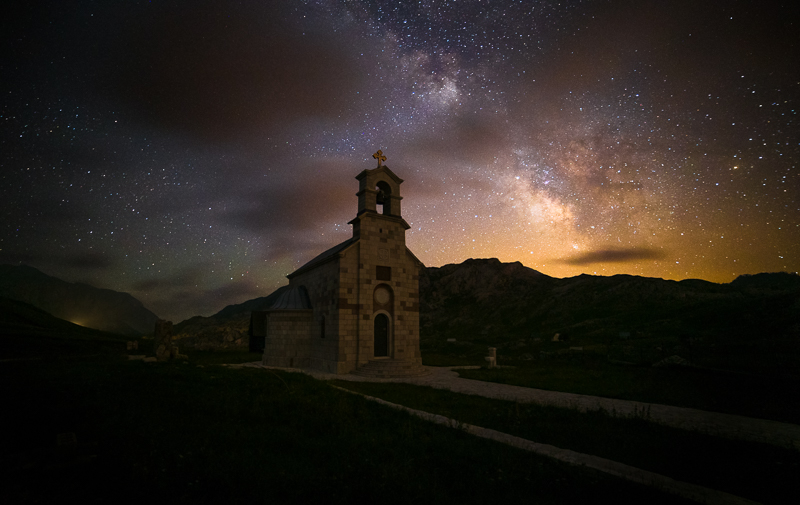
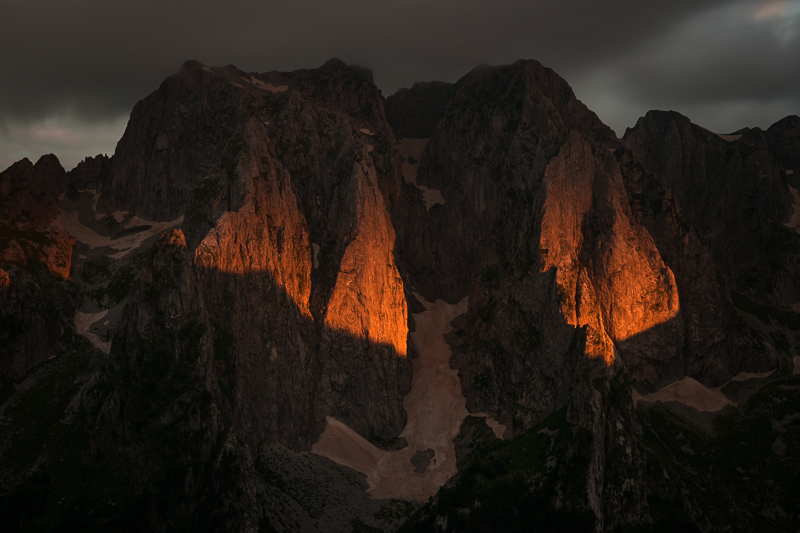
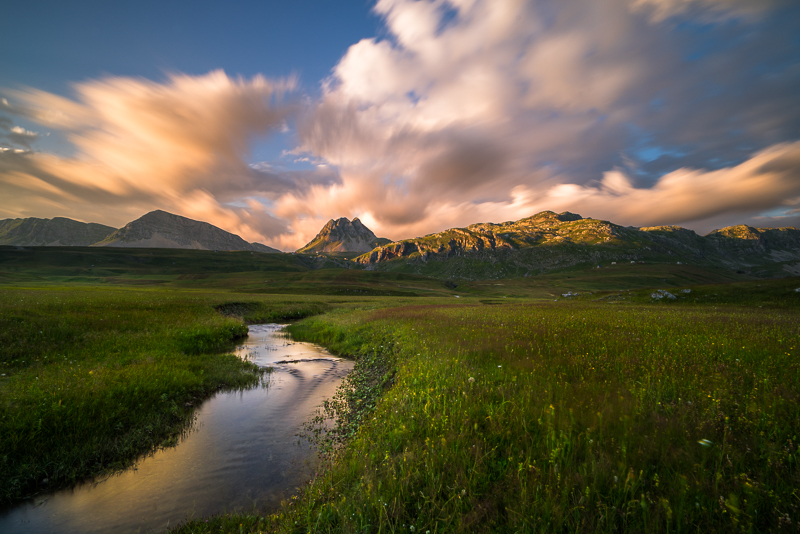
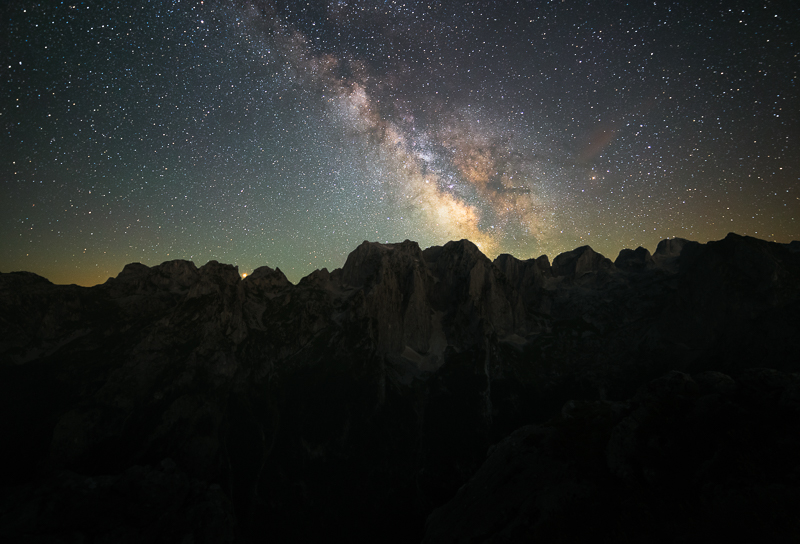
This year my girlfriend and I decided to go back again and make a road trip through the Balkans by car. This way we could see a lot and we had much more freedom this way.
You can roughly see our route on this map. It was not a dedicated photography trip but most of the time I brought my gear with me. The goal was to see some old cities, and most important, enjoy the wild mountains of Durmitor and Prokletije.
In this travel report I will discuss the photographic highlights at well know and unknown locations in this region, and of course discuss the gear I used during our trip.
What was in my bag?
Lenses
– Samyang 14mm t3.1
– Voigtländer 15mm f/4.5
– Sony GM 24mm f/1.4
– Loxia 2/50
– 7Artisans 1.1/50
– Minolta Rokkor 2/55
– Canon nFD 3.5/135
Cameras
– Sony a7s (ebay.de* | ebay.com*)
– Sony a7II (ebay.de* | ebay.com*)
Accessories
– Rollei C5i tripod (ebay.de* | ebay.com*)
– Intervalometer
– Dual charger
– Good head lamp
– Lens cleaning set
– Genesis Denali backpack green (ebay.de* | ebay.com*)
Links with * are affiliate links, if you buy something via one of these links I get a small commission that helps to keep the blog running, and it won’t cost you anything extra 🙂
As we were traveling by car there were no strict limitations on the number of lenses I could bring. Therefore I brought my Samyang 14mm t/3.1 for the case I wanted a very wide milkyway shot. I also brought three fifties, the Loxia for landscapes and stars, the other two for portraits as I like the rendering of both.
The trip from day to day
Disclaimer: We have mostely been sleeping in cheap, but well rated accomodations, more expensive ones might be better but I have no experience with them.
Omisalj
After two days of driving we arrived at the first stay in the Balkans, Omisalj at the Island of Krk, Croatia. Weather was not great and we arrived late at the location. I personally didn’t like Omisalj too much, it was a bit boring.
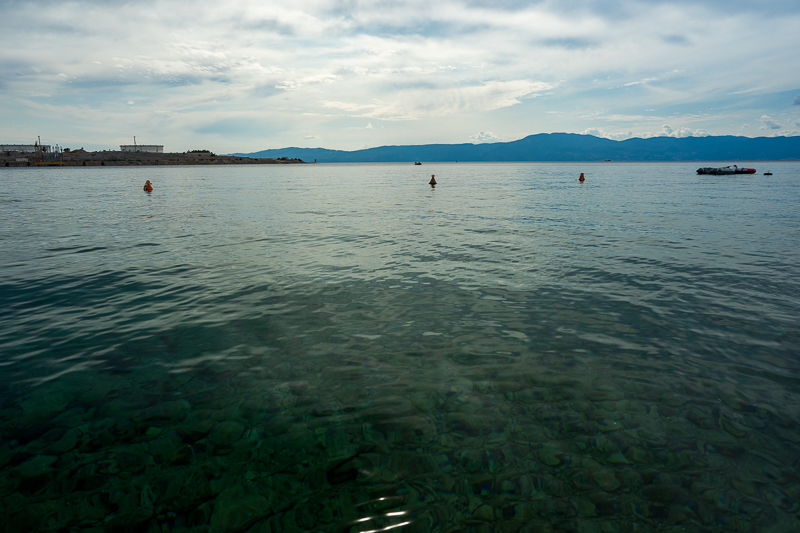
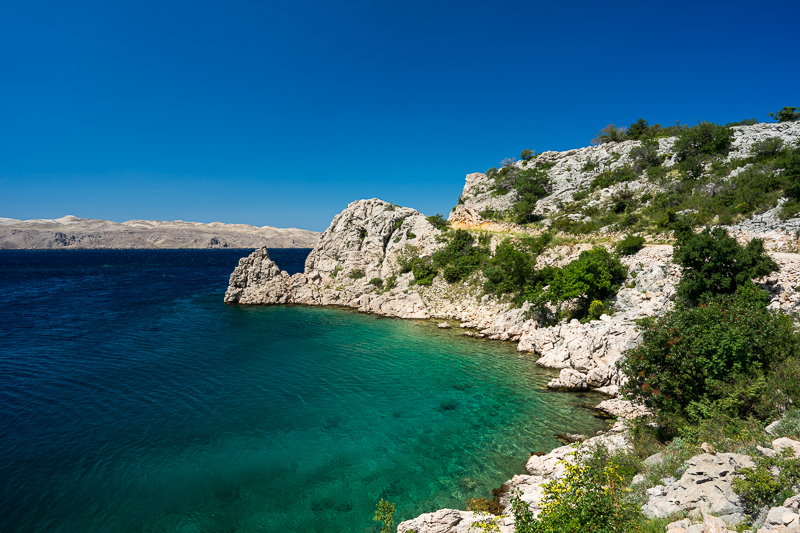
The next morning we continued to Knin, central Croatia, and drove a large part of the day along the Adriatic highway. Along this road there are some nice views on bays like the one below.
Knin
Knin was once a big and important city but nowadays most people have left. During the war Croatian soldiers have destroyed all property of the Serbs living there. Still a lot of buildings are broken as there is no money to rebuild them and no people that will live there.
On top of a hill next to Knin a very old fortress can be found. We only had a quick look before dinner and I didn’t take any photo’s there. If you have a bit more time than we had, I think it would be worth visiting.
A bit outside Knin a beautiful waterfall (Slap Krčić Knin) can be found. Light was very difficult and I only brought two lenses (GM24 and 7A 1.1/50) which was a bit unfortunate. The CV 4.5/15 would have been great here. Nevertheless I took a few pictures that I like.
Oh before I forget: a bit upstream is another waterfall, we didn’t know that unfortunately..
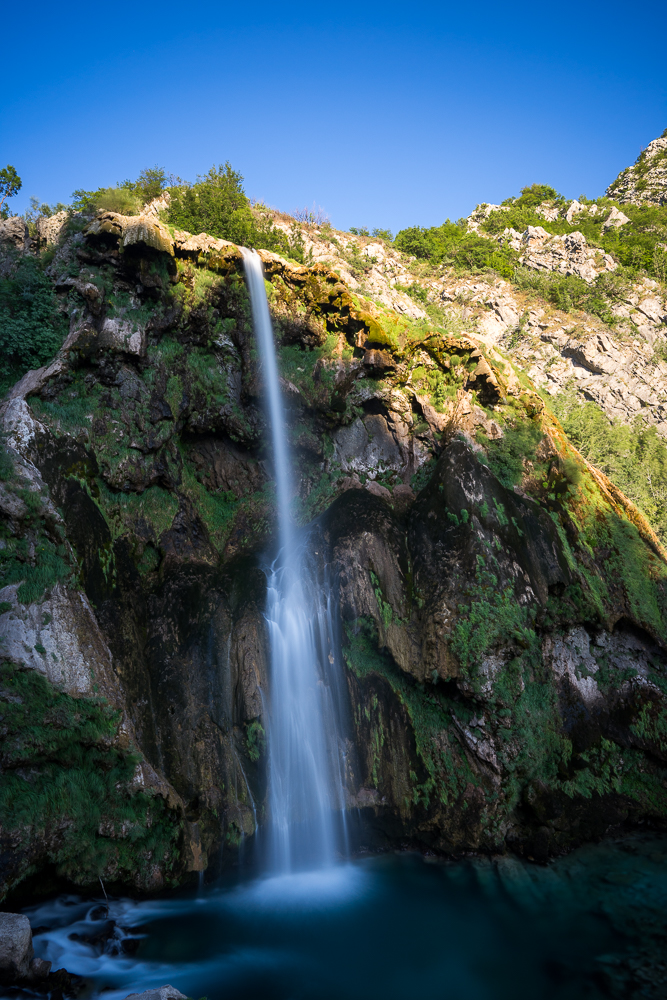
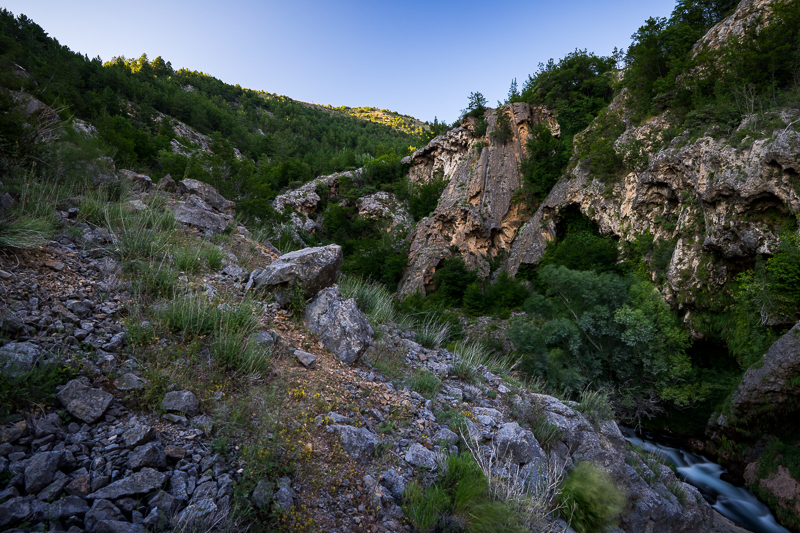
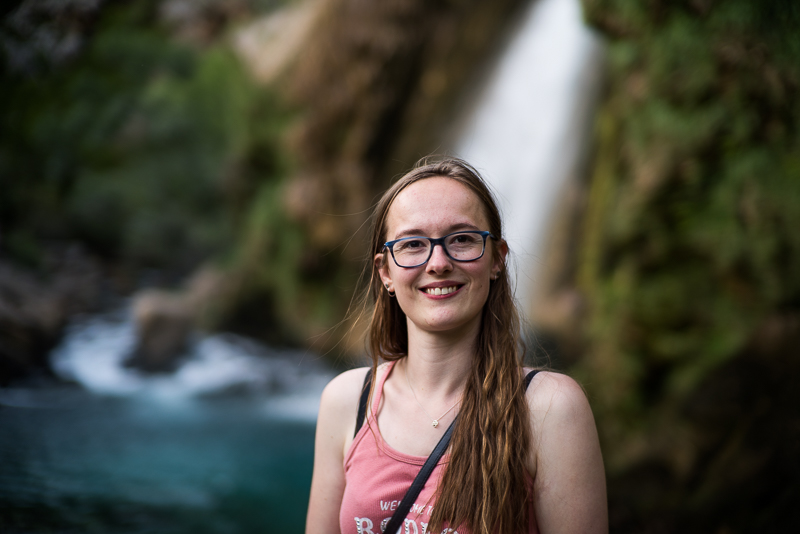
Mostar
The next day we arrived in Mostar (Bosnia and Herzegovina) after a few hours of driving. Mostar is a very old city where the signs of the Balkan war are still very visible. Many buildings are covered with bullet holes and a bit away from the touristic part you can find destroyed buildings covered with street art. For photographers Mostar is a very interesting destination.
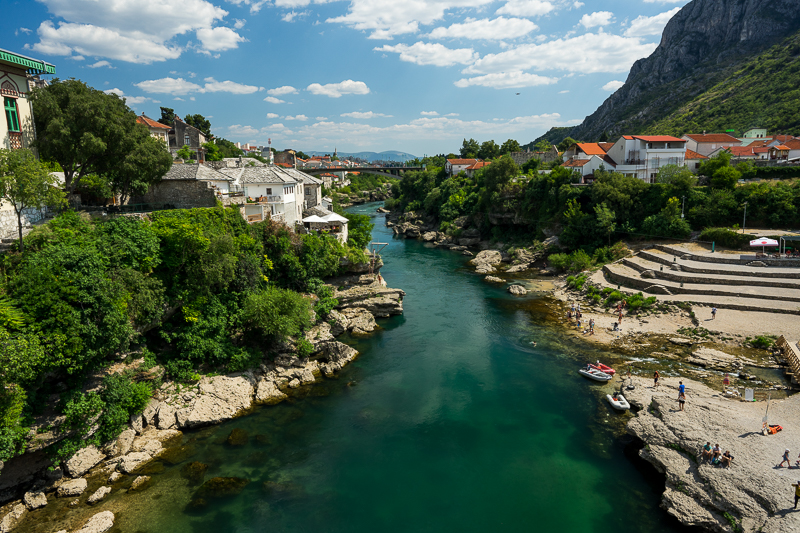
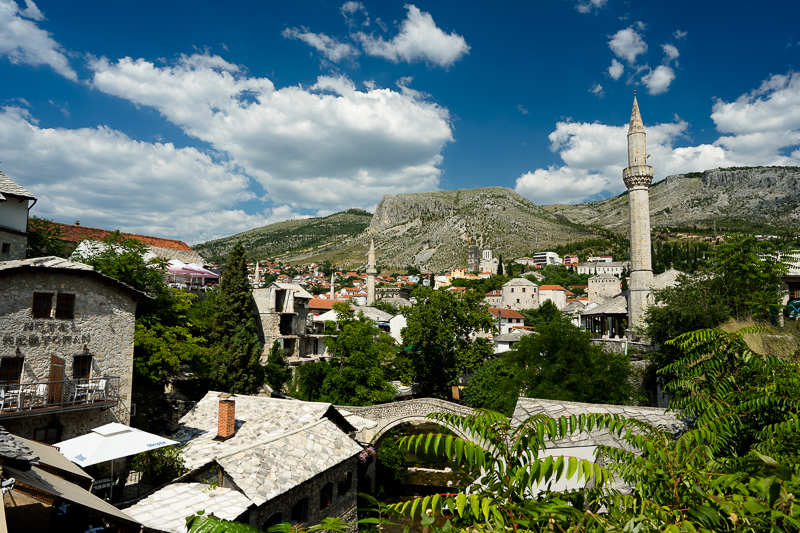
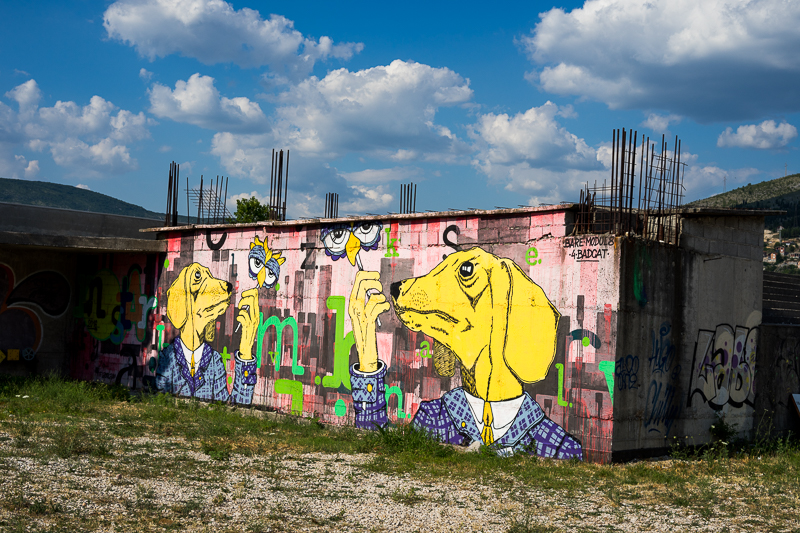
The very center of Mostar is very touristic with a crowded, very old bazaar and the famous Stari Most bridge. Certainly worth to visit, but I would do it in the evening as it is very crowded during daytime. The tight streets also look much more appealing in the soft light of the evening and are a lot of fun to photograph.
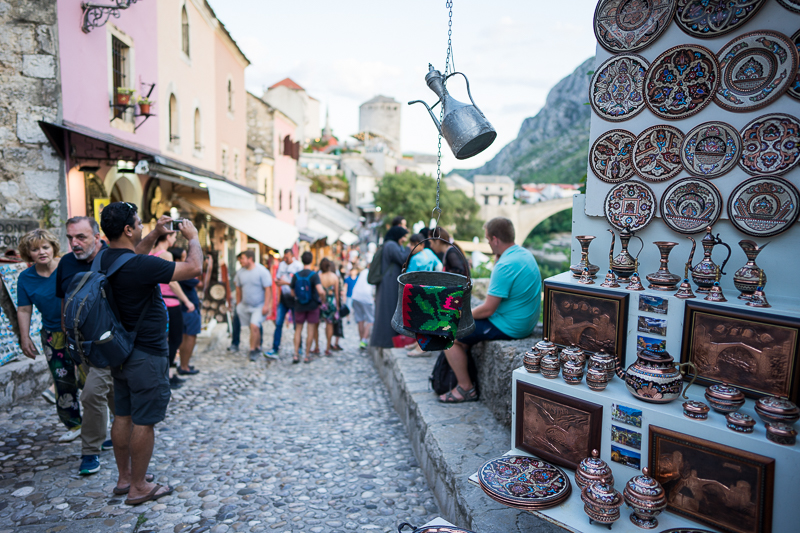
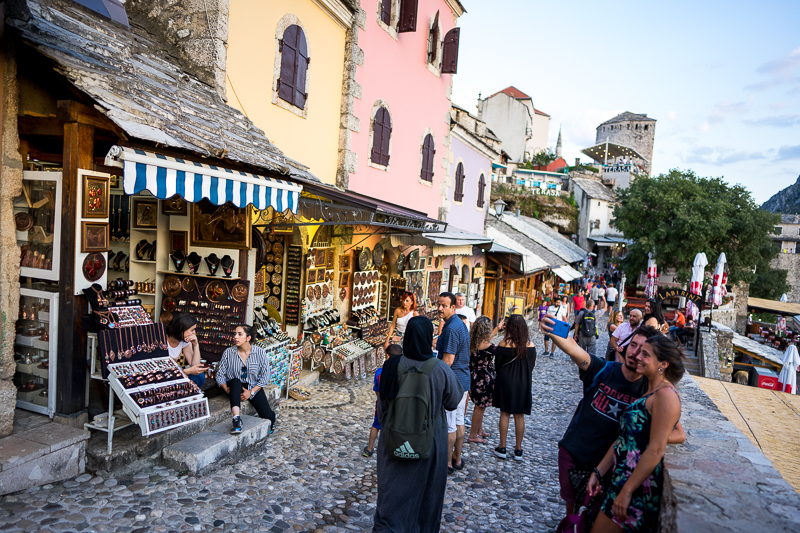
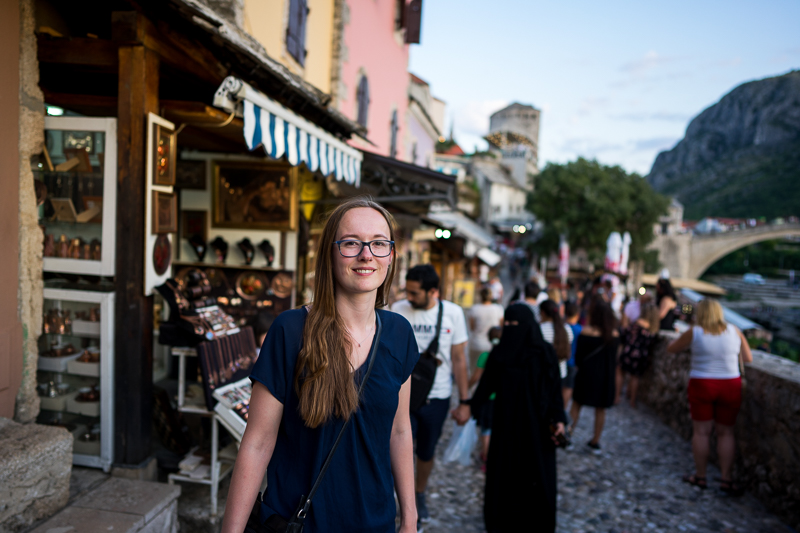
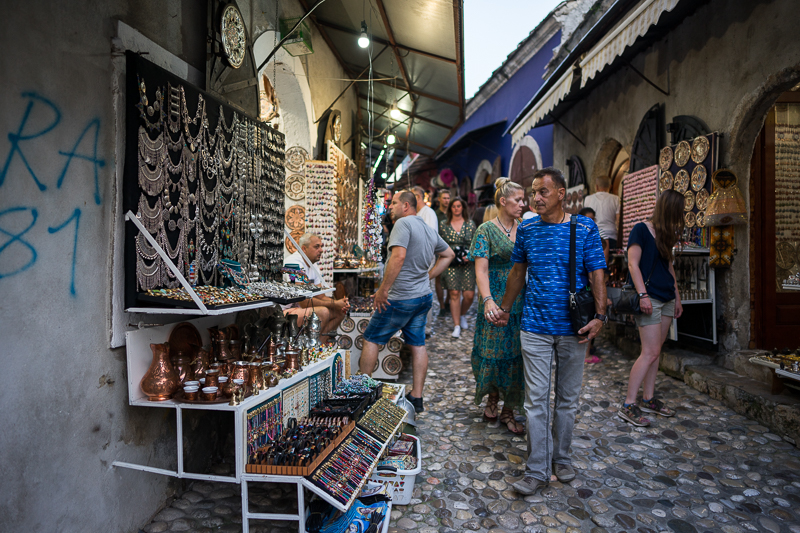
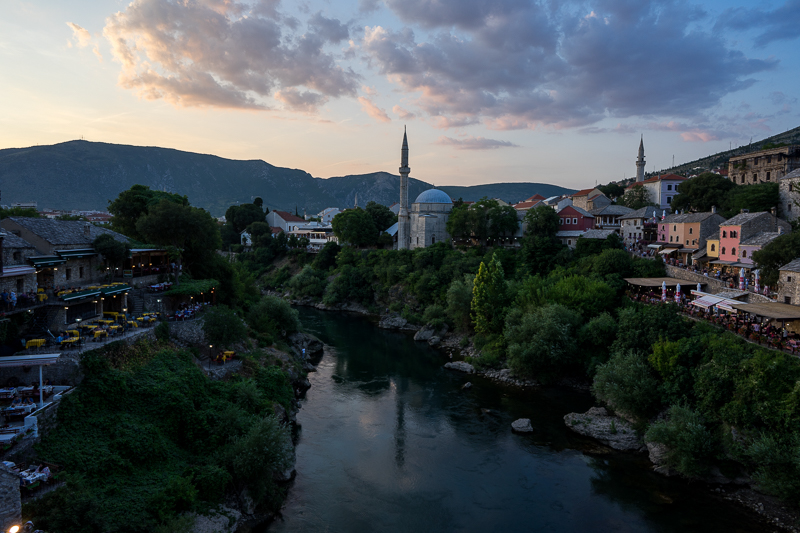
If you walk a little bit away from the crowds near the bridge, past the sewage pipes you can climb on some rocks which gives you a different composition than the standard one (caution, the rocks are very dirty and it stinks).
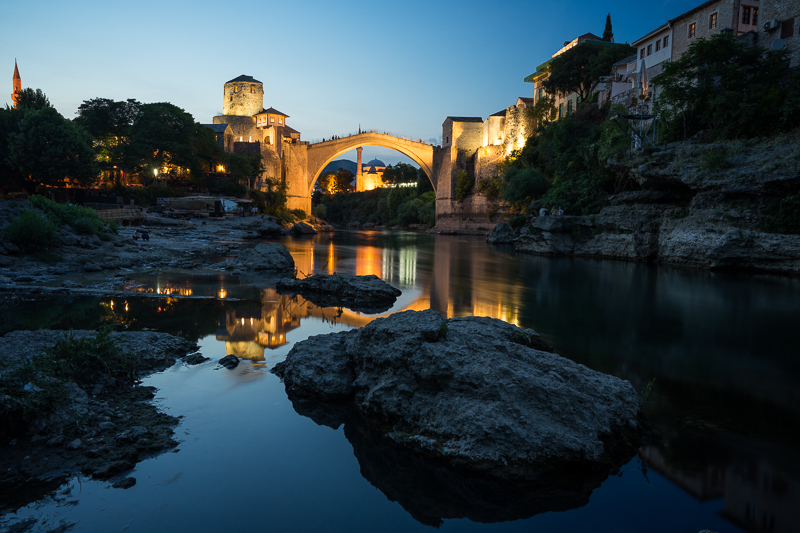
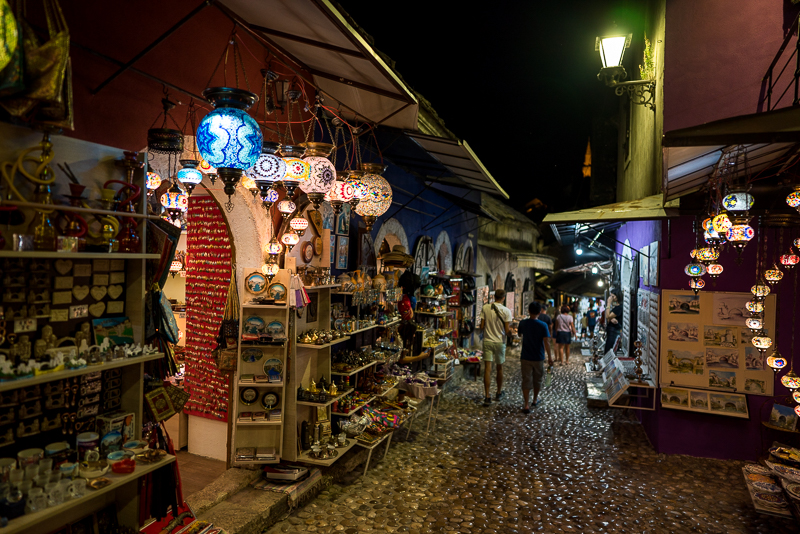
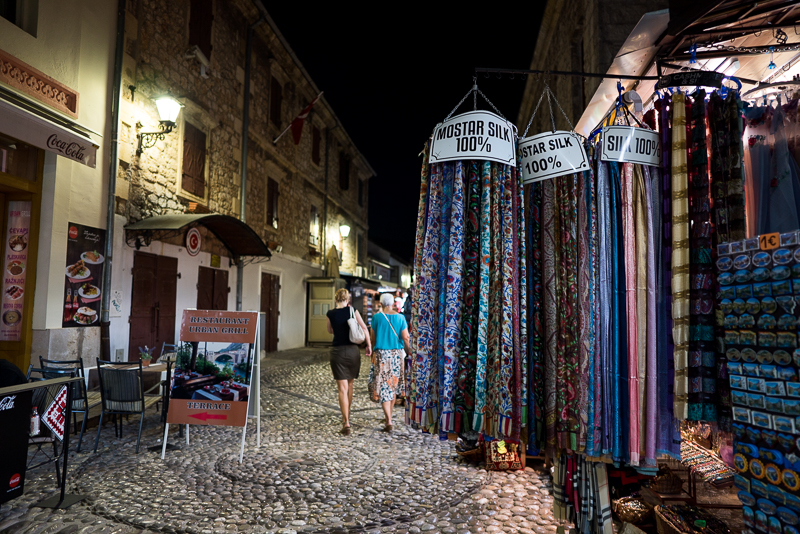
In the south east of Mostar you can find the “sniper tower of Mostar”, a former bank building that was used by snipers from Croatia to shoot at Muslims in the neighborhood across the street. Near the tower everything is covered with bullet holes, buildings, trees, the streets, simply everything. Street artist made some impressive artworks around this location were terrible things happened. If you visit Mostar you should really visit this place where most tourists don’t go to and you see the “real” Mostar and its terrible recent history. It all left a deep impression on me and I still get a strange feeling when I look at the photo’s of the street art here.
I still regret I only visited this location at daytime, due to the dull light the photo’s don’t reflect well how impressive this place is.
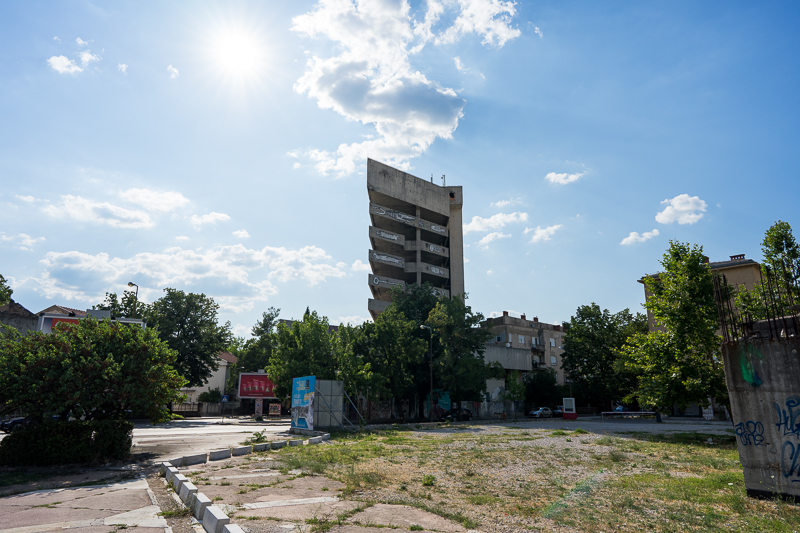
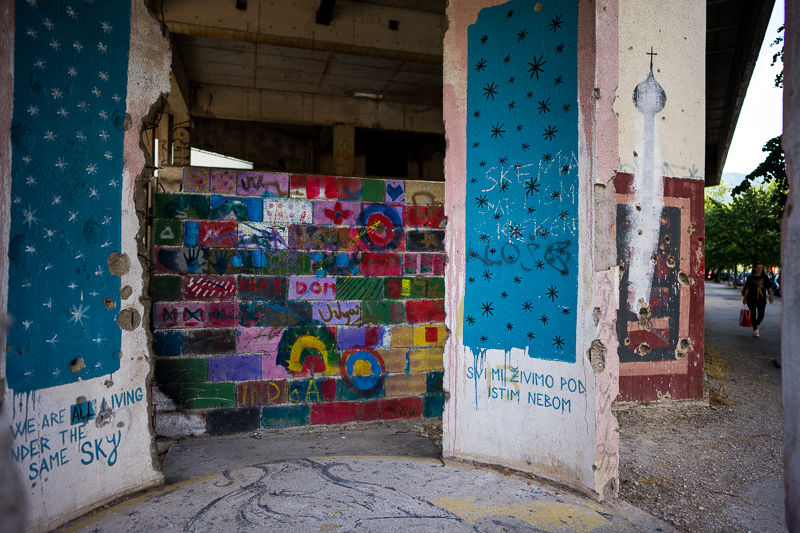
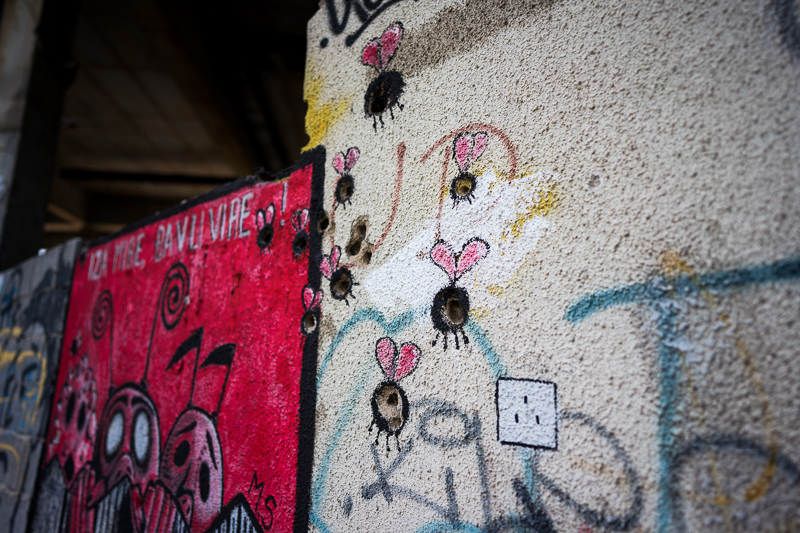
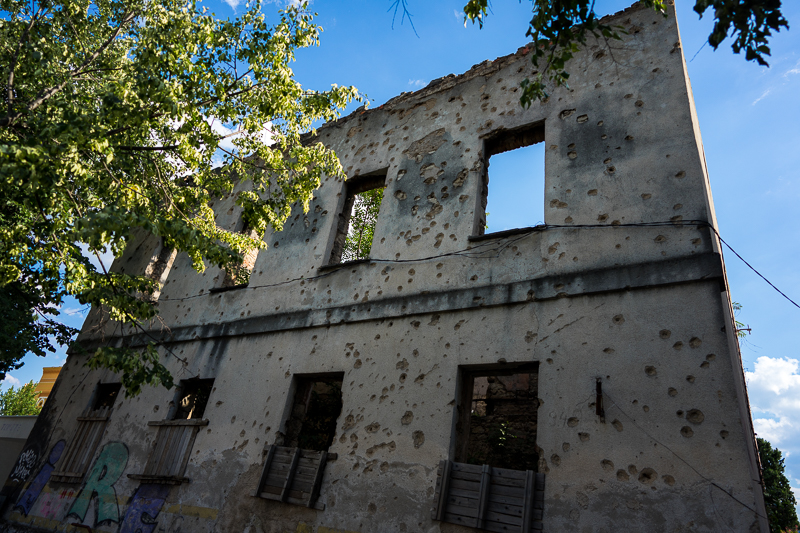
Kotor
After one night in Mostar we continued to Kotor. A very old coastal town positioned in the Bay of Kotor, Montenegro. The modern part of Kotor isn’t too interesting in my opinion. However the old town of Kotor is very, very nice. This part of the city is surrounded by old city walls at the coastal side, and steep mountains at the other side. Within the walls there are numerous small streets and cozy squares. At night the old city is nicely lit, therefor one can take pictures without a tripod at reasonable ISO settings.
We entered the old town at the end of the blue hor from the south side. Here one will be treated on some very nice reflections at calm days.
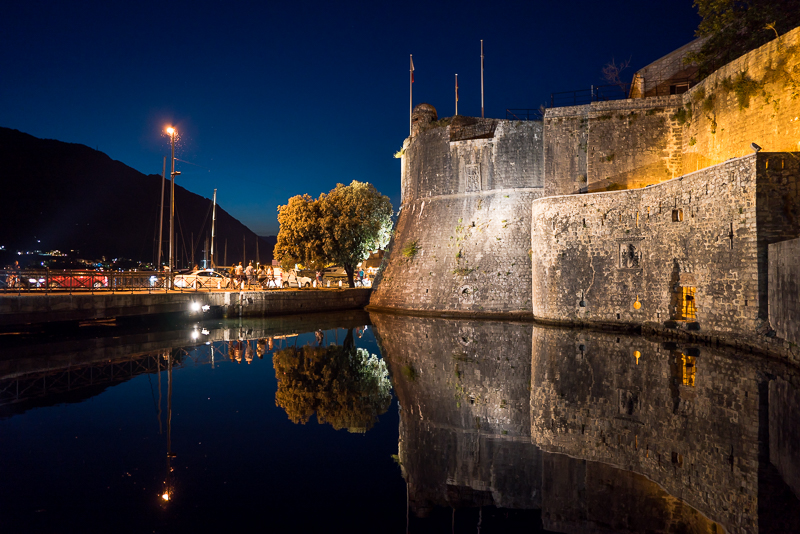
In the center of the old part there are some very cozy squares, also nicely lit. In the evening the terraces are crowded but the streets are relatively empty. In combination with the good light taking pictures at this time of the day is very rewarding.
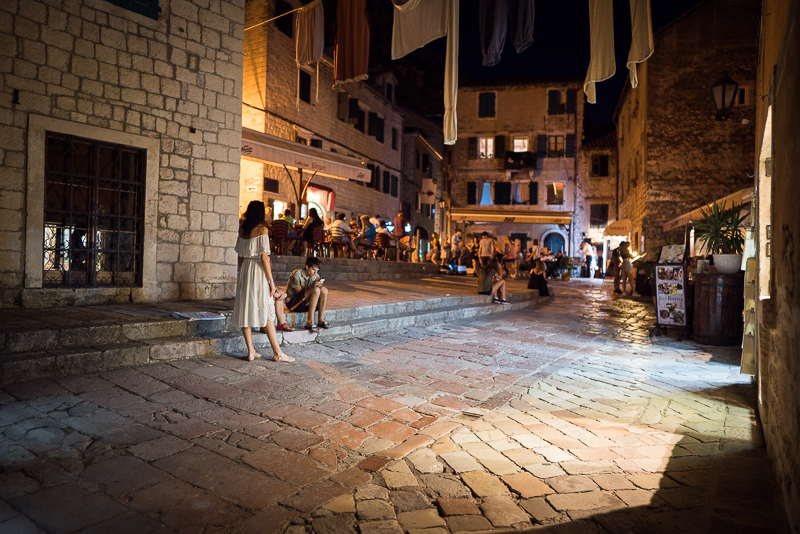
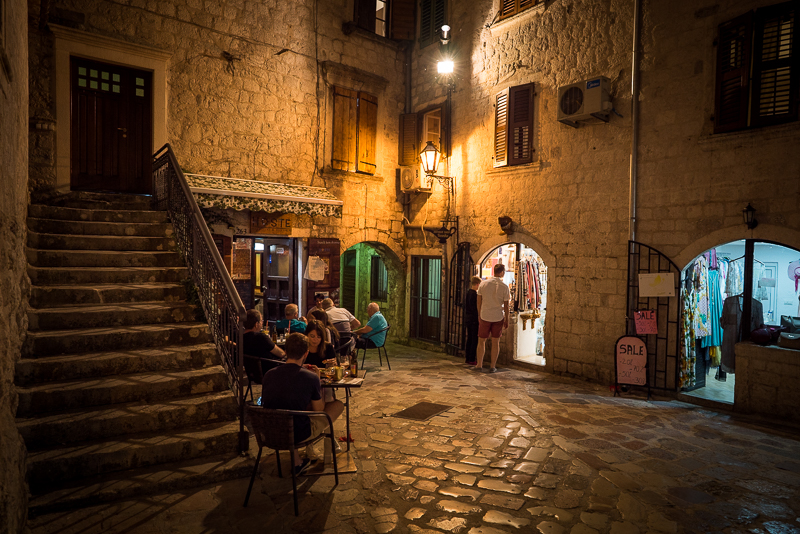
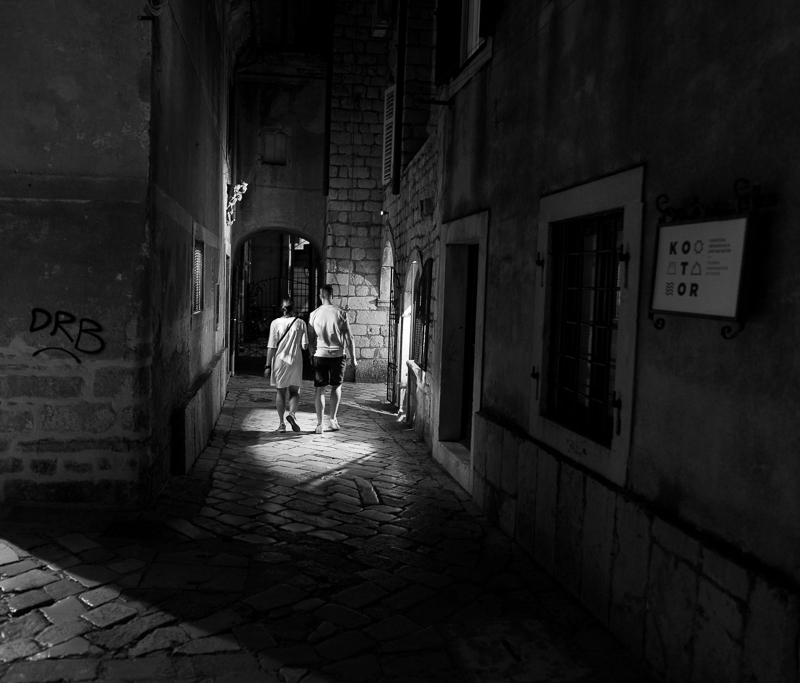
There are also some wider streets in the less crowded parts. Here the ambiance is really good, and more important, these locations are fun to photograph.
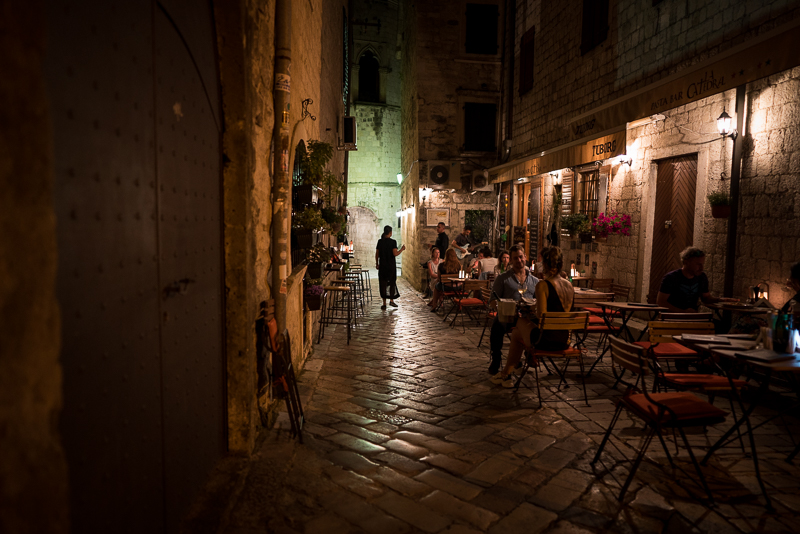
National park Durmitor (Zabljak)
After some days on the road we drove to Zabljak (Zablijak), a mountain village near the Durmitor mountain range. We drove via the R18, a mountain pass. This route gives you great views and some empty roads in acceptable shape.
Zabljak is a relatively touristic and modern city. In the second world war the town was burned to the ground so houses are not that old. Since Zabljak is relatively touristic the paths are maintained well, which can not be said about some other regions in the Balkans.
We planned to do several hikes in the national park, but due to the weather and a back injury of my girlfriend we only managed to do two big hikes in the time we were there.
Our first hike went to the Bobotov Kuk, the highest peak of the region and one of the highest peaks of Montenegro. We parked at Sedlo around 1900m altitude. From there you can take a very nice walk to the Bobotov Kuk along beautiful meadows with lots of flowers.
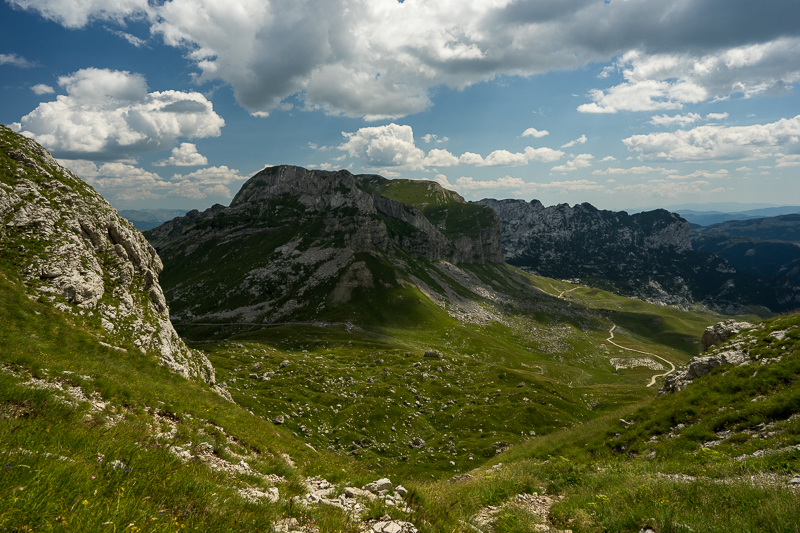
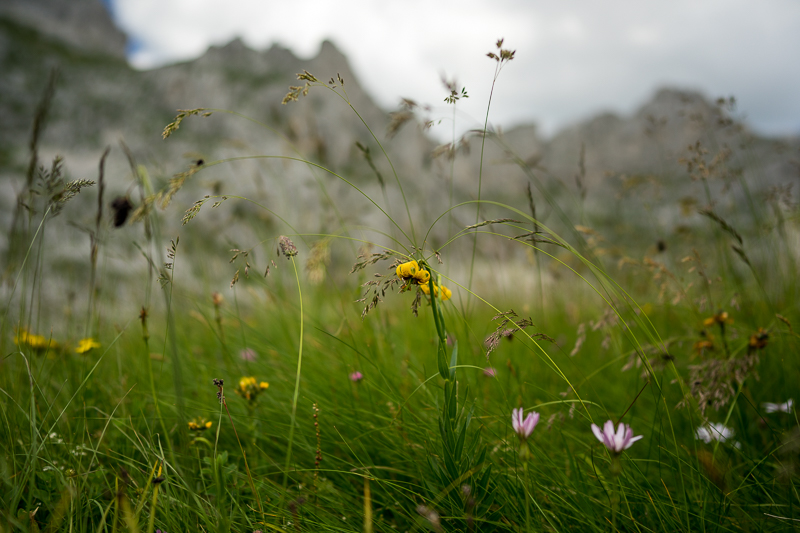
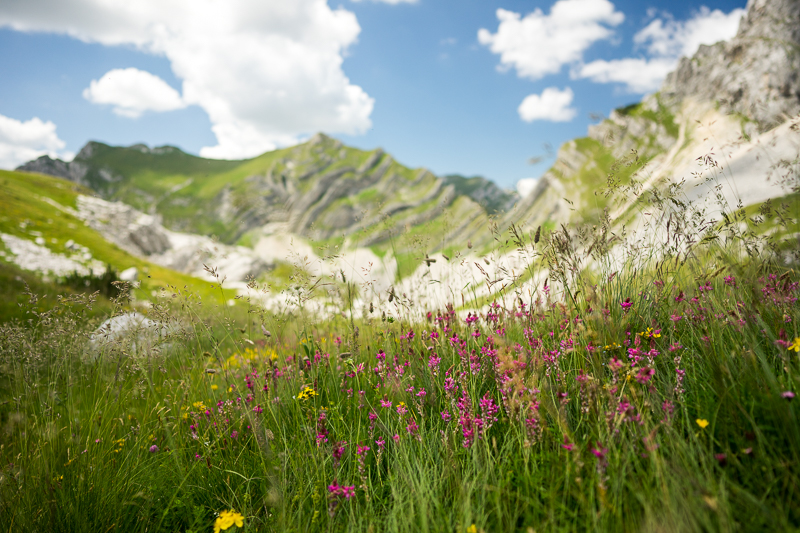
At around 2300m altitude one reaches a pass which gives you a nice view over the area. From this pass it is a relatively short hike towards the top.
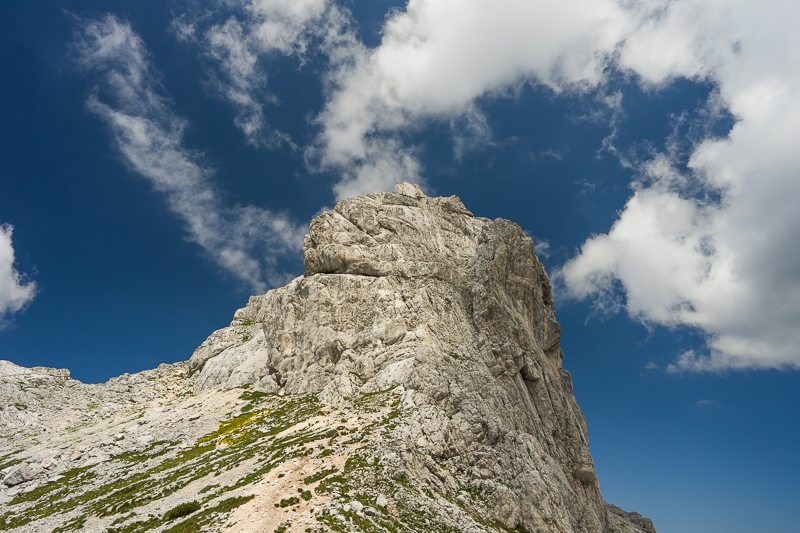
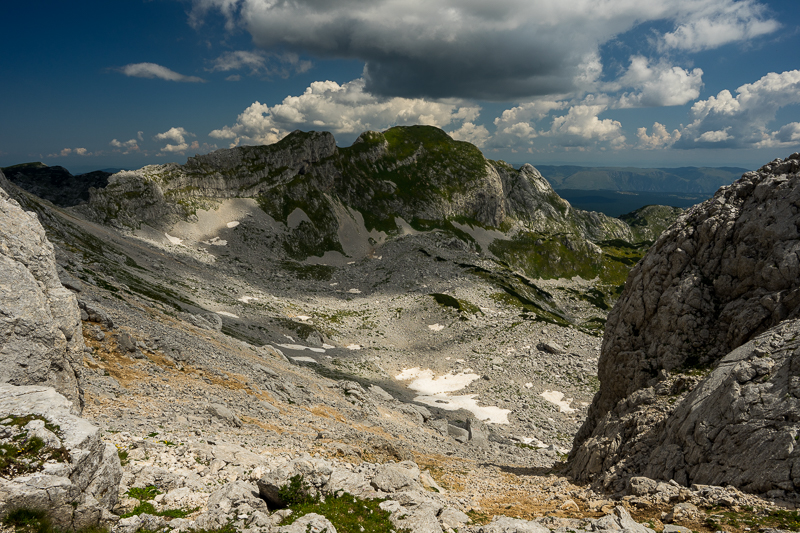
The route gets more rocky here and fear of heights isn’t handy here. Close to the top you get a great view on a lake at the other side of the mountains. If the heights don’t bother you its is very rewarding to go there!
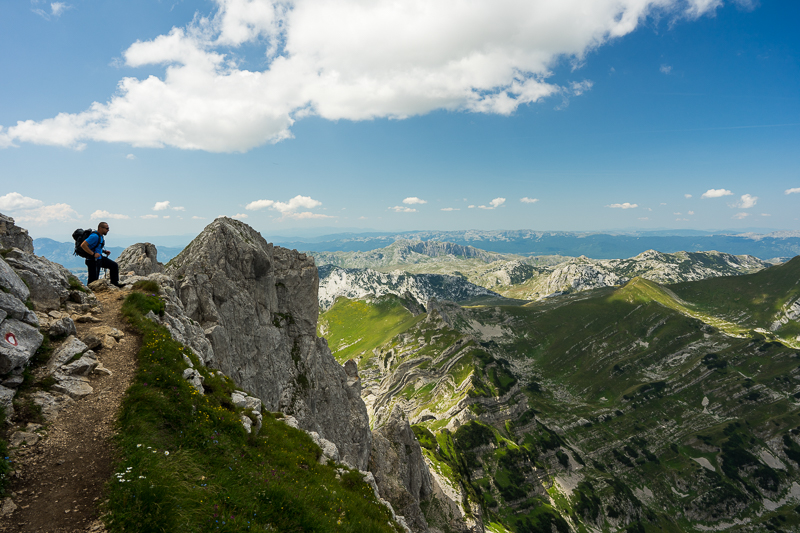
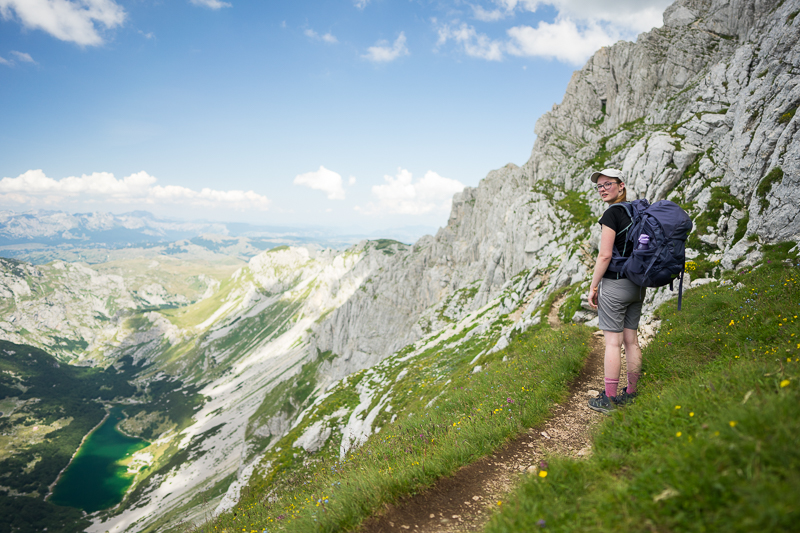
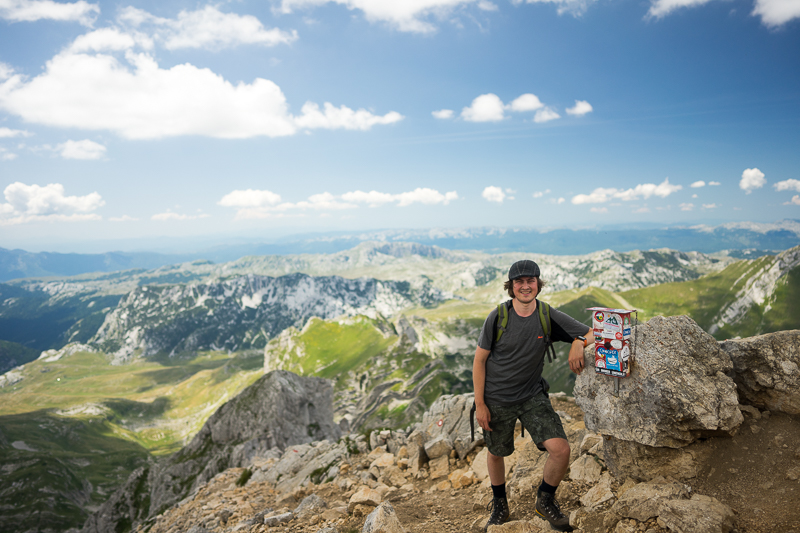
Our other hike brought us to Ledena Pecina, which translates as ice cave. Due to the bad weather forecast, thunderstorms in the afternoon, we decided to start very early at 6.15.
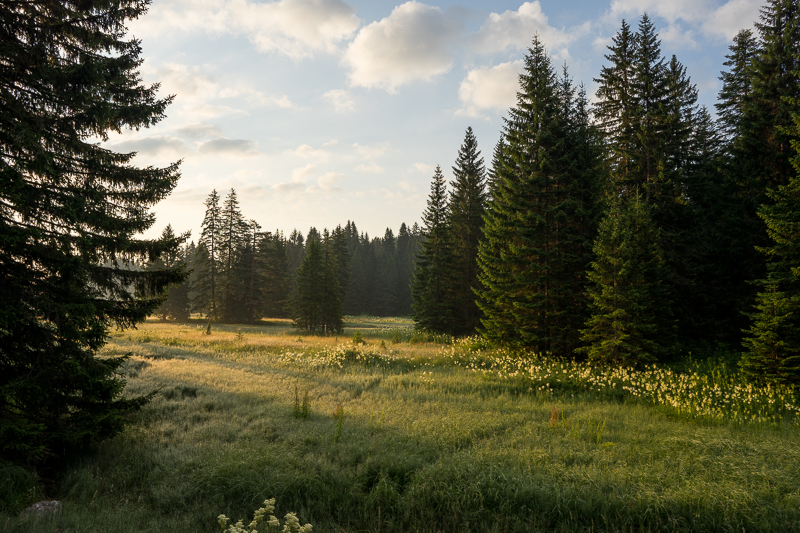
We started our hike at the entrance of the nation park near Crno Jezero (Black lake), from there it is a 6-7 km long hike to the cave. The route isn’t very technical but one has to conquer a significant height difference. The path wasn’t maintained very well at our route towards the cave, only few people walk here. The pine bushes were growing on the train at some spots which made passing those spots with a big backpack not easy.
However, despite these difficulties it is certainly worth it. The route is beautiful with great views very interesting vegetation (the latter is especially interesting for biologists like me 😉 ).
Since we were in a hurry I only took a few shots outside the cave unfortunately.
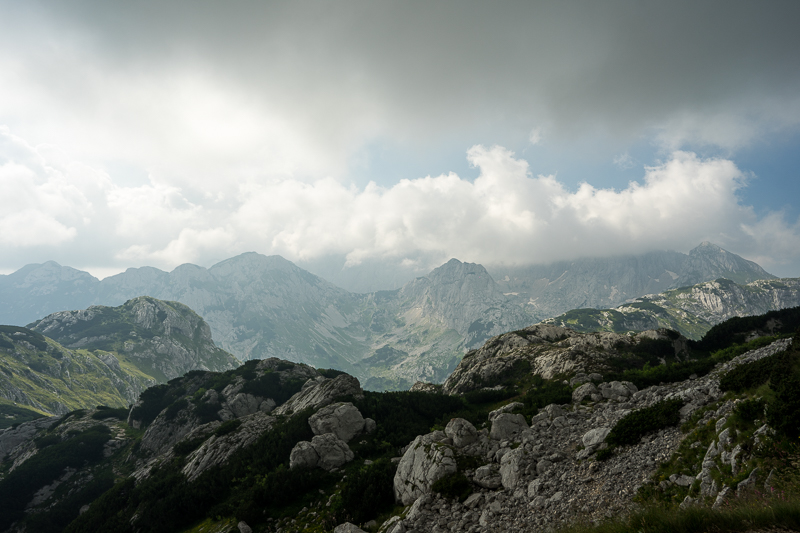
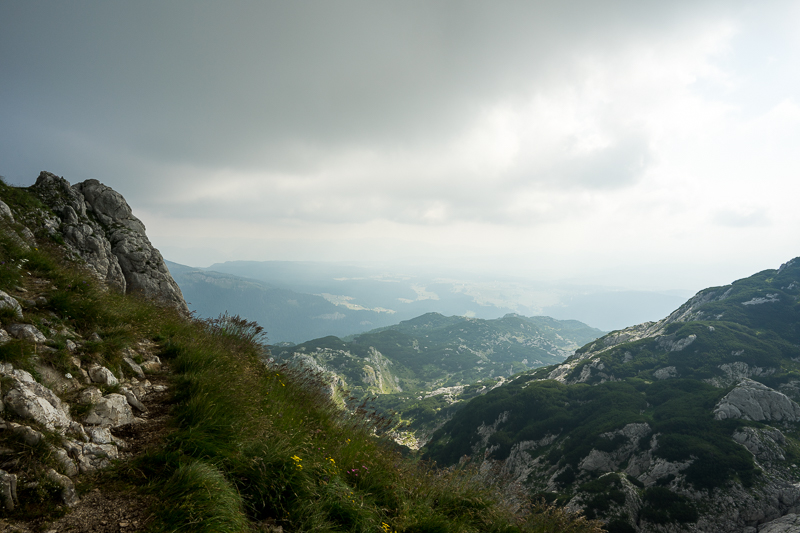
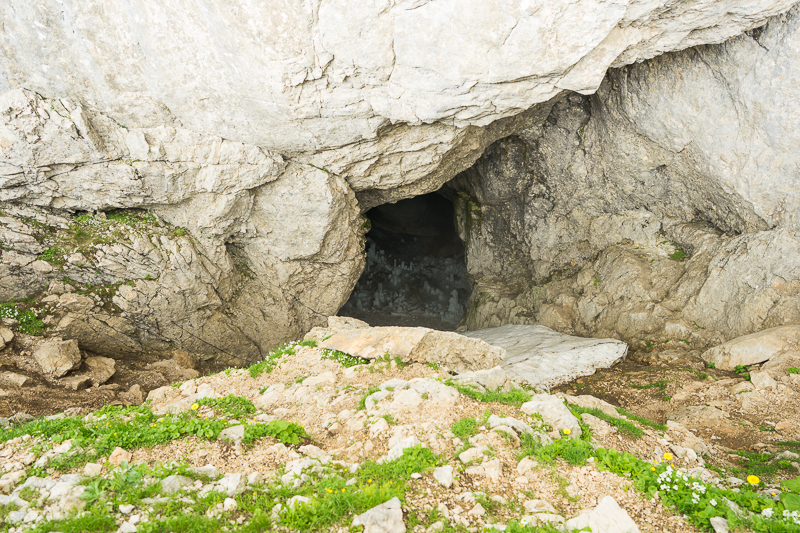
The entrance to the cave was a very steep snow/ice patch which makes entering a bit difficult.
Inside the cave one encounters stalagmites made from ice, some even 2 meters high. Earlier in the season they will probably be even larger and later in the season smaller. We were the only ones there so I could take pictures freely. During the decent some large rocks dropped from the ceiling of the cave so look good at what’s above you before you decide to stand somewhere in the cave.
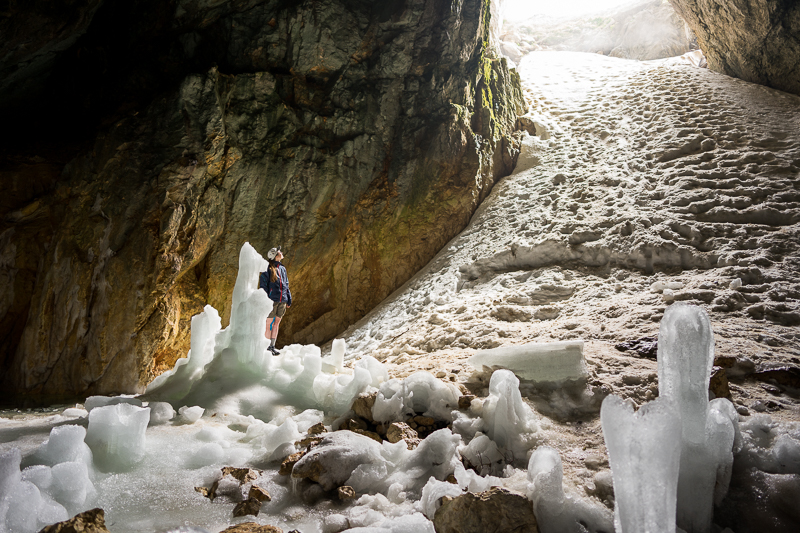
The cave itself is quite dark so a tripod is recommended as you need relative long exposures. Also bring a jacket if you plan to take some pictures in the cave as the temperature is really low inside.
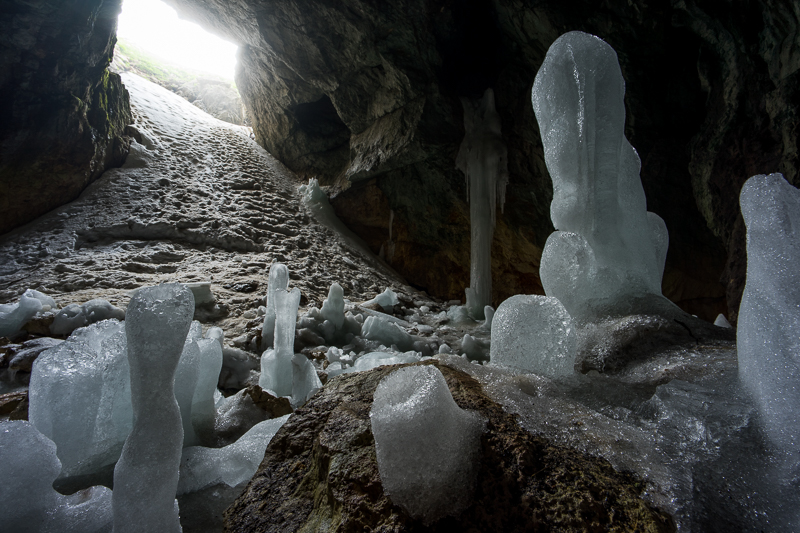
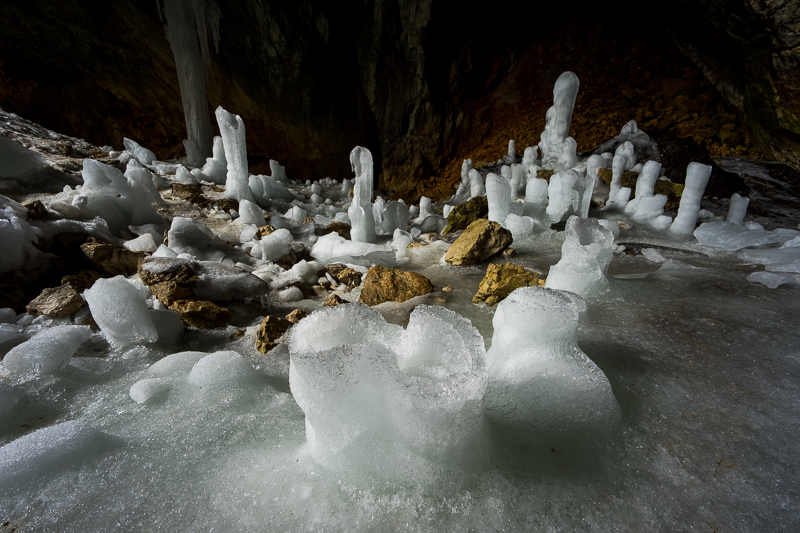
In between these hikes we took a drive to the Tara canyon and the “Most na Tari”, the bridge over the Tara. The Tara canyon is the second deepest canyon in the world and with its 1300 meter high walls the Grand canyon is only 200 meters deeper.
It is nice to see but also very busy with tourists. Zip lines around the bridge and the amount of tourists makes it hard to find a nice composition.
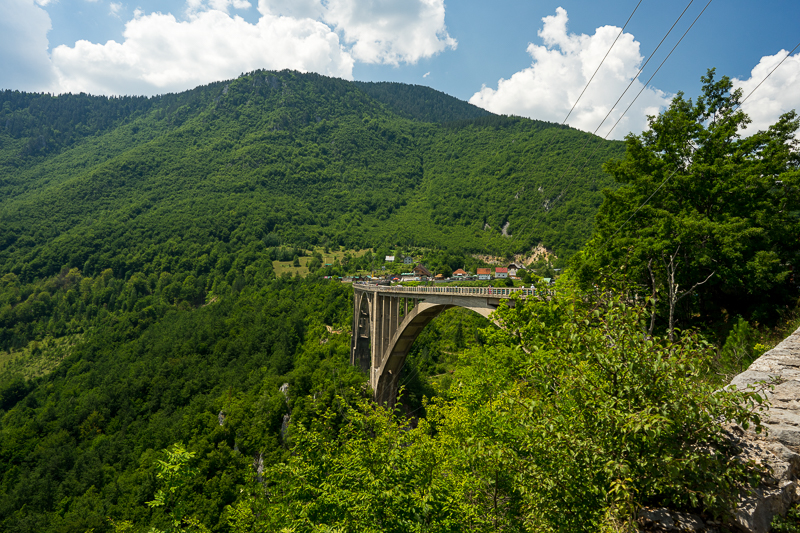
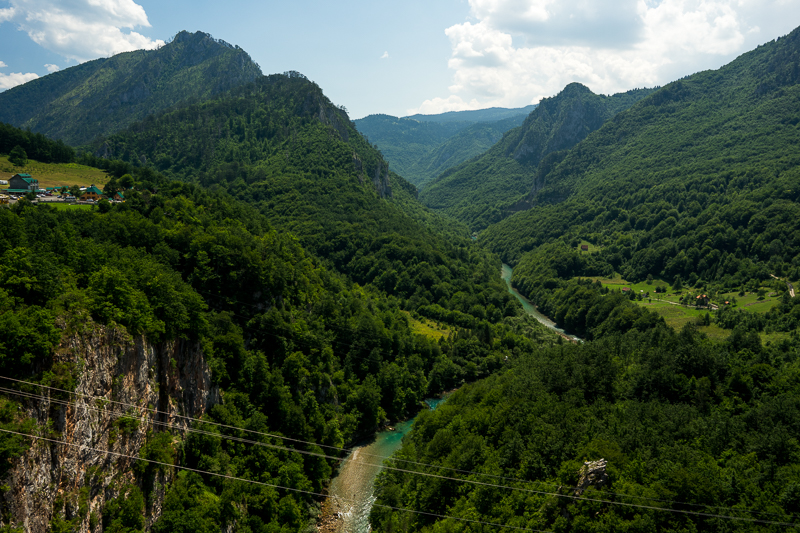
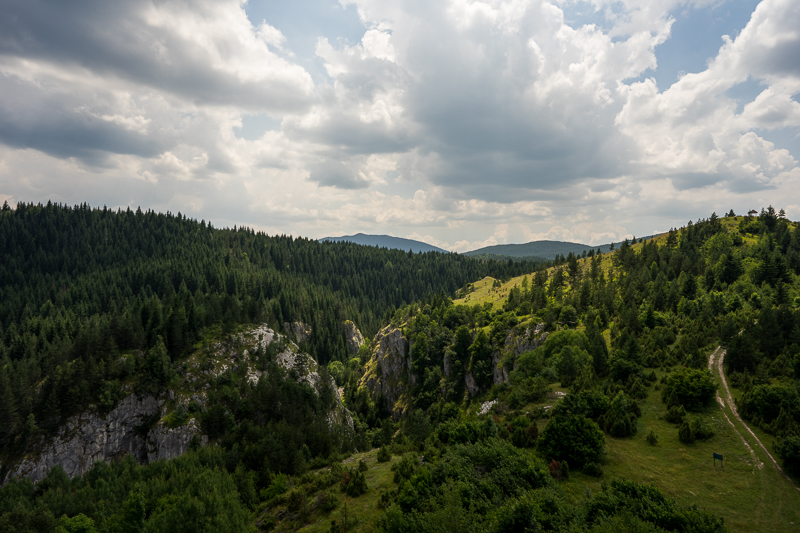
On the way back to Zabljak we shortly visited a viewpoint near Pirlitor. I can not recommend to this this with a normal car as we had some serious trouble to get back to the main roads with our Skoda. Nevertheless it is very nice to visit with a very nice view.
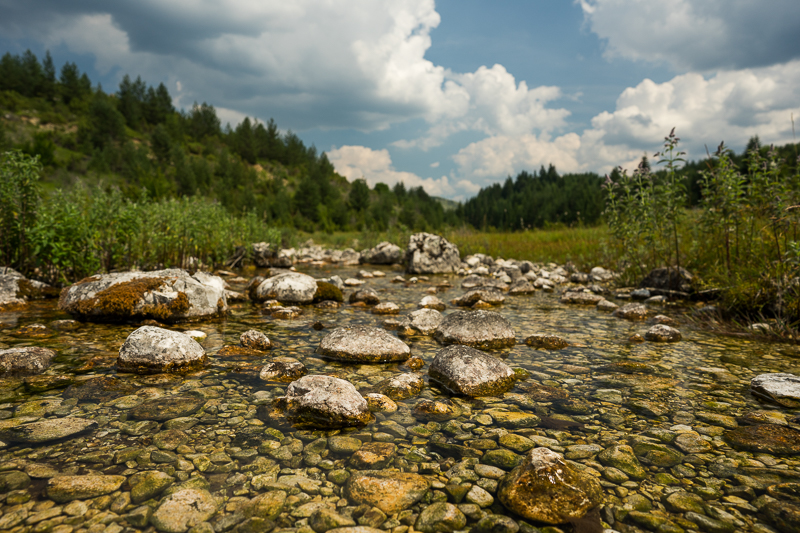
In the evening we drove to Sedlo to catch the sunset, but unfortunately circumstances were mediocre. I think that one should be able to make some very good compositions there with better light. This spot surely stays on my sunset and milky way bucket list.
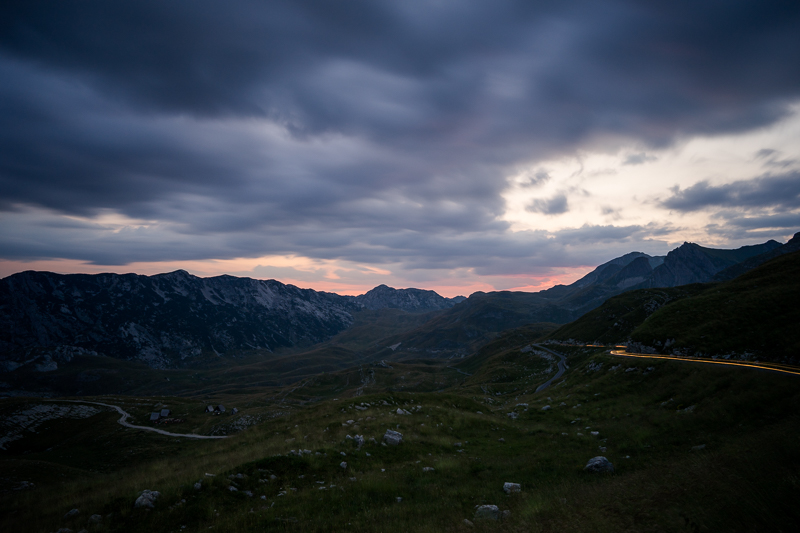
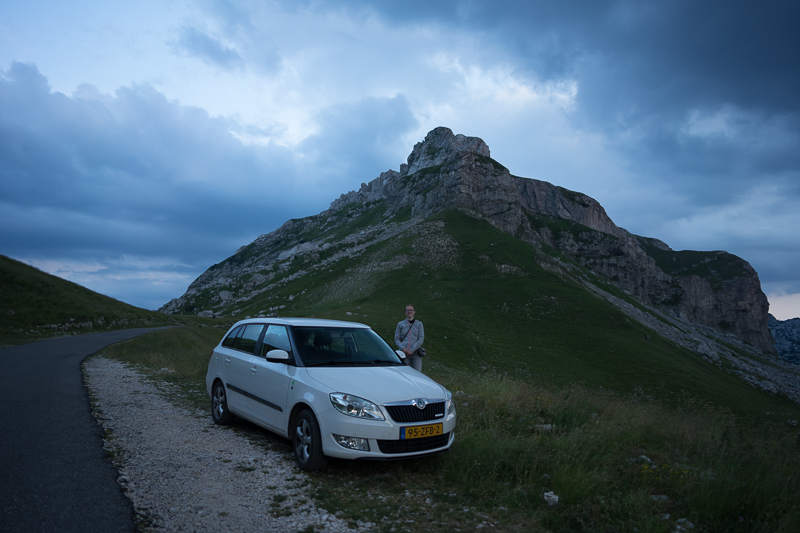
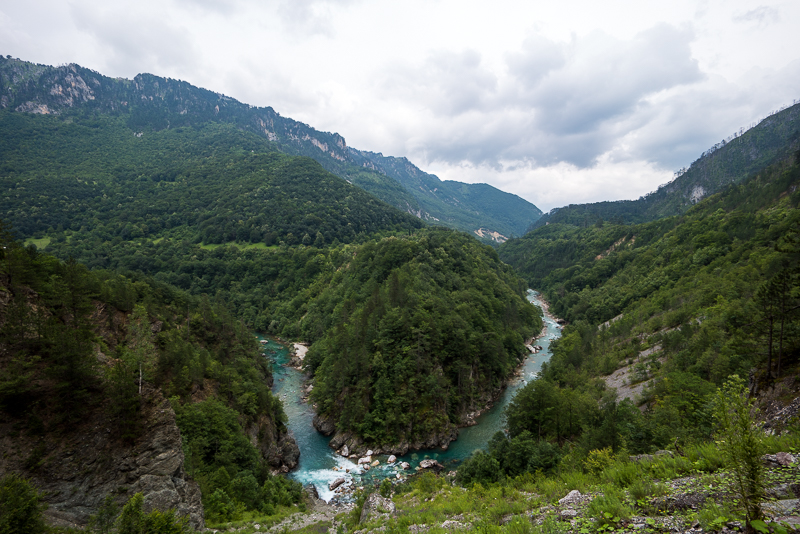
From Zabljak we drove to Vusanje via the Tara canyon. A nice road to drive with it’s own horseshoe bend.
National park Prokletije (Vusanje, Gusinje, Plav)
My earlier journeys to Montenegro were mainly focused on this region. Prokletije (pronounced as prokletiah) is the youngest national park of Montenegro and lays at the border with Albania and Kosovo. During our hikes we often crossed the border with Albania, without a special license called “red tape” this officially is illegal. However we never had it and never had any form of control. Unless you decide to go down to a village at the other side you should do fine without it. In advance of our first stay in the region we tried to get it and contacted the police several times but we never got any response…
This region is also one of the poorest regions of Montenegro it seems. The number of unfinished houses is higher than in the rest of the country, and the most striking sign is the number of stolen cars! According to the internet 70% of the cars there are stolen in Europe and the USA, a fair share of these still carries its original licence plate. To make things more silly: in the Village of Plav to our estimate 25% of the cars had a licence plate from New York. Most stolen cars are very expensive ones, so if you go there with you own normal car they wont steal it, and as a lot of the cars still carry their original license plate they won’t even know which cars are from tourists 😉
The Prokletije mountains are characterized by very rough and high rock walls which are very impressive. Especially the Grebaje valley will leave a huge impression, nowhere I feel as small as I do there. One can also hike in the mountains here, but as the less busy routes are maintained really badly a GPS device is a handy tool to not get lost. I you love rest those impopulair routes a very recommended, one can walk the whole day with hearing or seeing someone else. We unfortunately only were able to do two serious hikes this year, but those were beautiful and I will discuss them below.
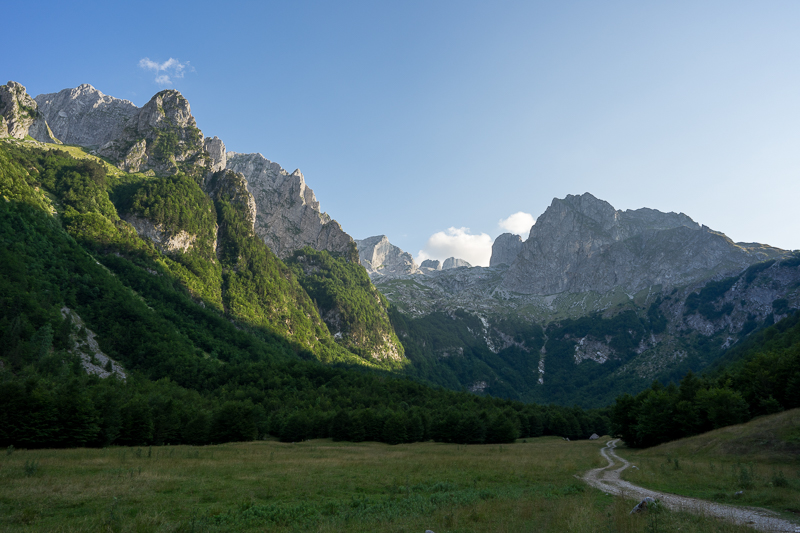
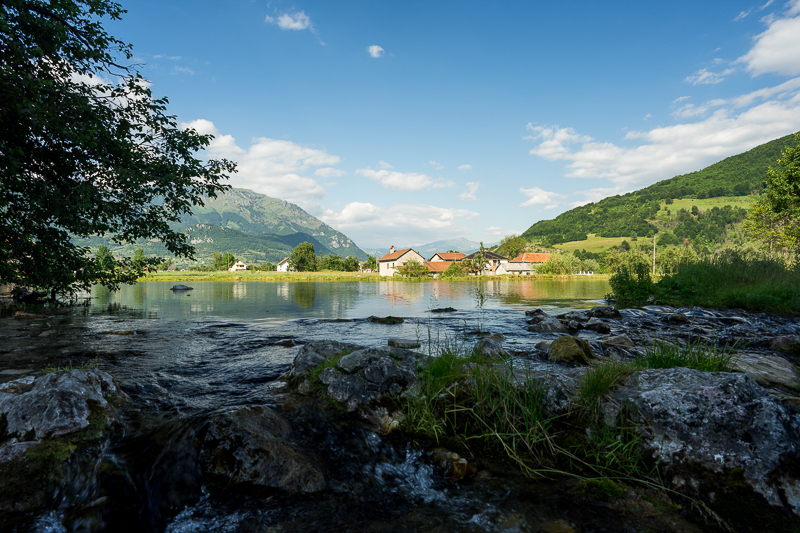
We arrived at our first stay in Vusanje (Eco Katun Rosi, nice people and clean room!) late, so there was no room for any serious hiking. Therefore we decided to visit the Ali Pasha springs. At this location crystal clear water reaches the surface and spreads quickly towards Vruja river. Quite a nice location for those days you don’t hike but still want to see something nice.
The next day we got op early to visit the Buni i Jezerces, a valley with several lakes which is just over the border with Albania.
We parked our car just outside the village of Vusanje next to the Canyon Grlja. From here you walk the first kilometers on a gravel road to Zastan Karaula (1350 m), here you can buy something to drink. The couple that lives there with their animals is really kind and their English is surprisingly good. If you like to know more from the locals these people are fun to talk with.
From the Zastan Karaula on the track get smaller and steeper and you walk through a beautiful beech forest until you reach more open terrain with very old pines (1750 m).
Once you are here you have very nice view along the valley, and it is not far to the first lakes anymore.
There are several lakes in a very nice scenery. There are several high rock walls, beautiful flower fields and if you lucky even some snow.
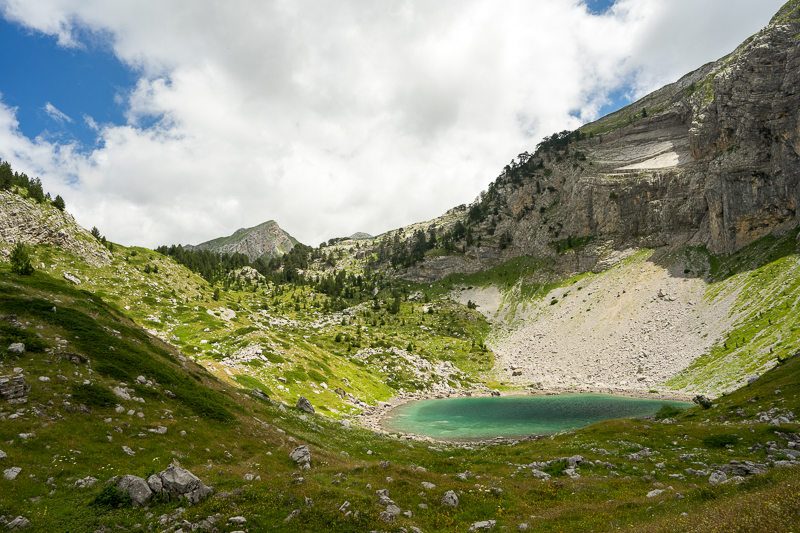
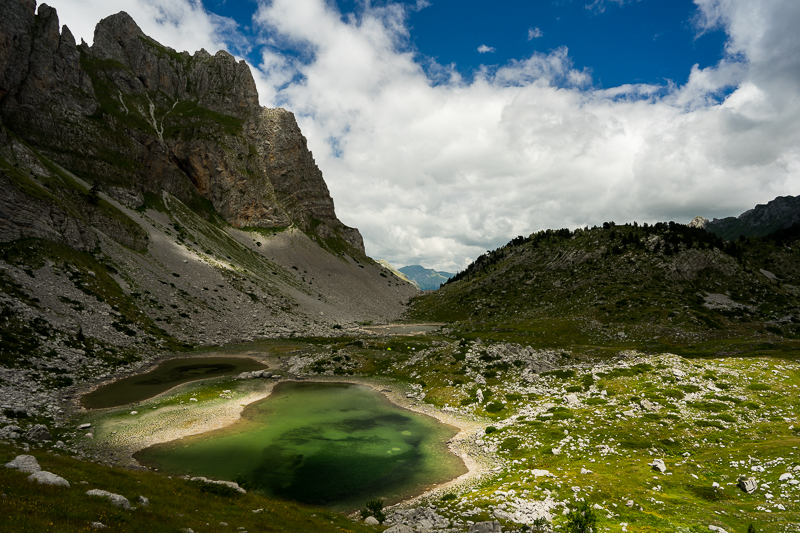
At the end of the valley one will find the biggest lake. We took a break here, but unfortunately the light was disappointing because of thick clouds. With nice light it is much more interesting. This spot is often used as a base camp to climb the higher peaks, and I would love to camp here one day to capture the milkyway.
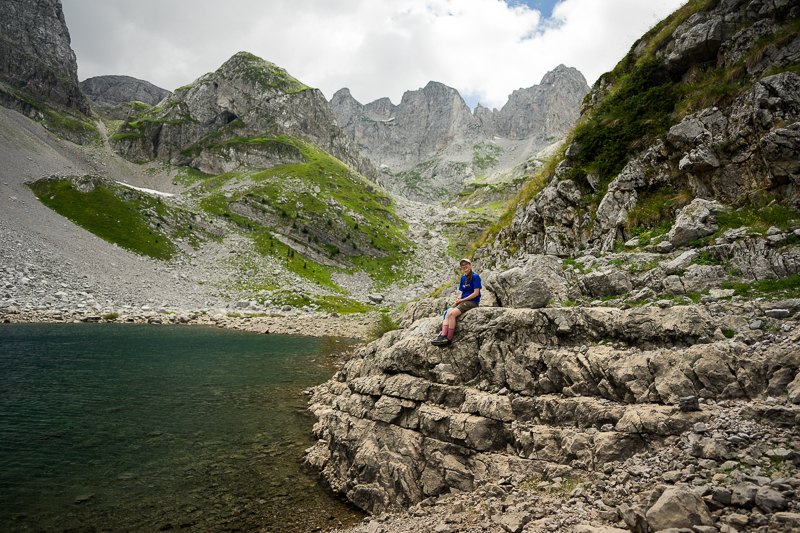
At the way back in the valley you have a nice view on some rock walls. We also took a quick stop at Oko Skakavice (Blue eye/eye of a grasshopper), a 9 meter deep spring with ice cold, crystal clear water. Again the light was dull and it was crowded here. Therefore my pictures of this spot were disappointing.

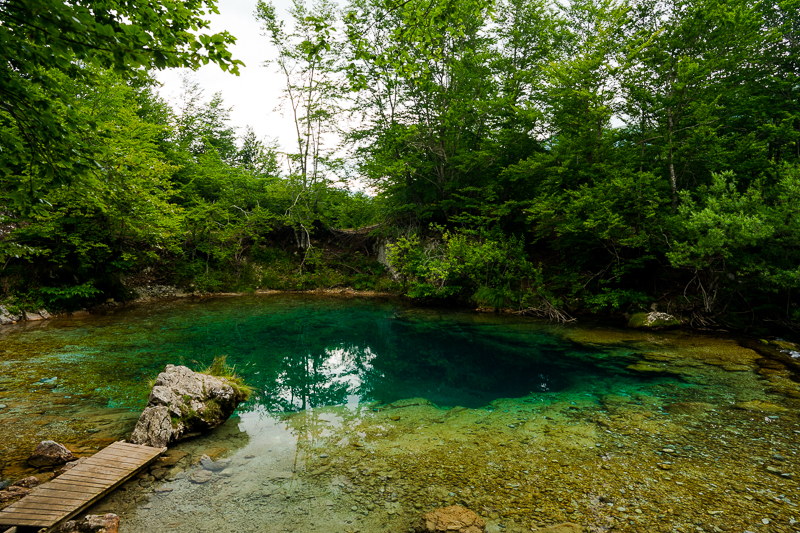
After the hike we drove to Katun Maja Karanfil in the Grebaje valley to stay there for some days. I really love the valley and it is without any doubt the most impressive valley I have ever visited.
During all my earlier visits I stayed at Katun Maja Karanfil, the staff and manager Ismael are really nice and helpful. Try to get one of the bungalows if you plan to stay here, they have some rooms in the main buildings but those are significantly less comfortable.
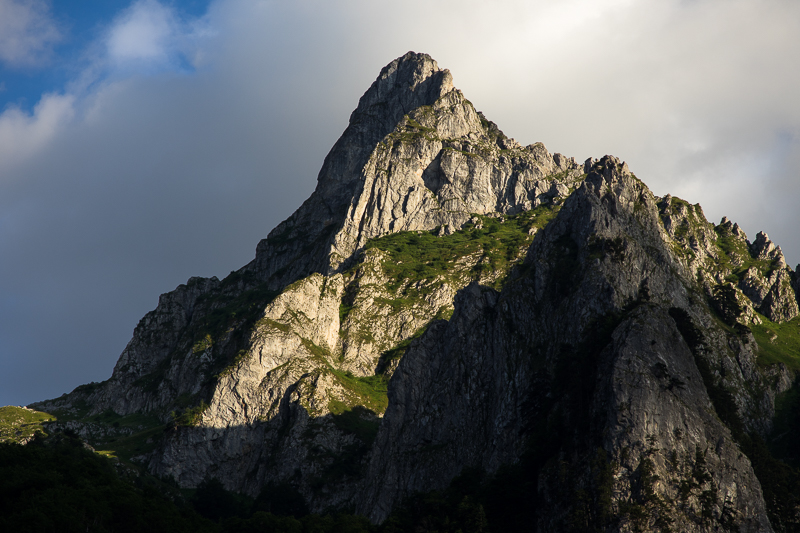
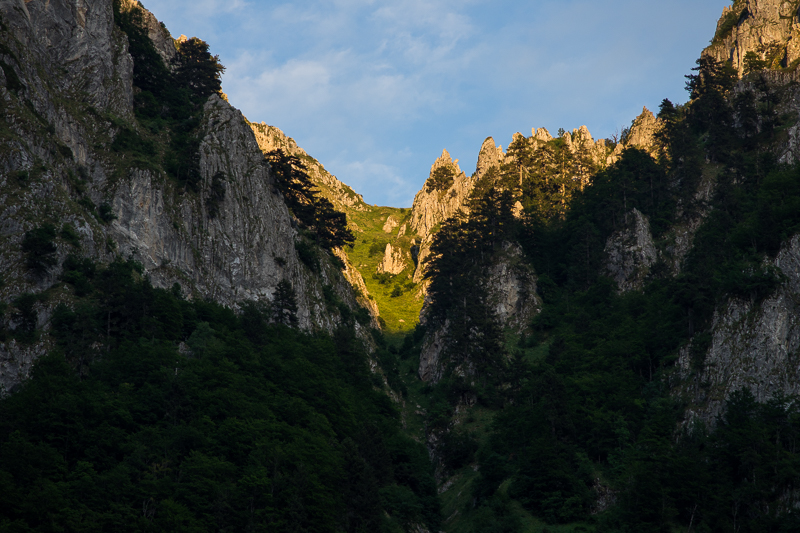
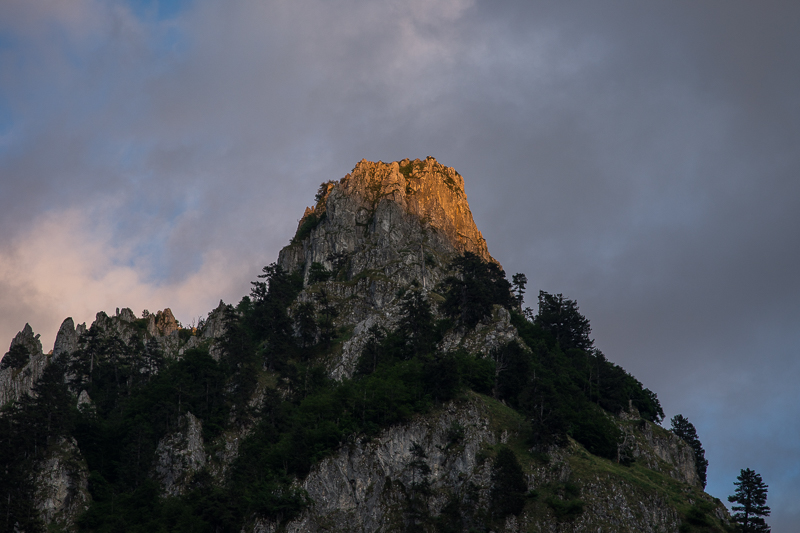
During our dinner at the restaurant we had some great light, luckily I brought my a7II and Canon nFD 3.5/135 so I could capture it.
At days with some clouds during sunset this light is often present here.
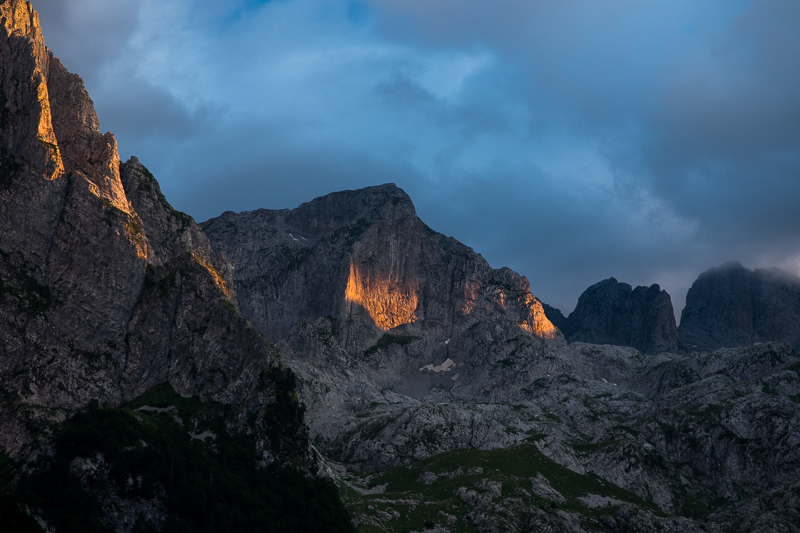
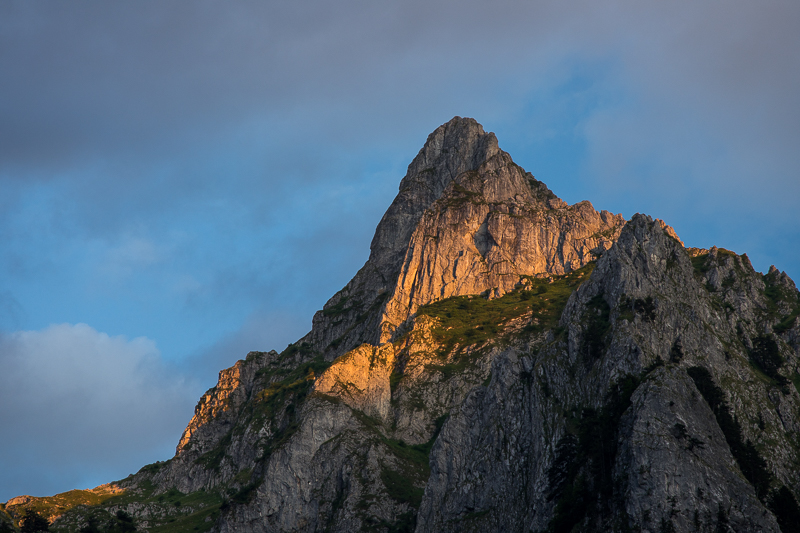
The next day we decided to wait till the evening to hike to a peak to watch the sunset and the milky way from there. I did this two times earlier from this spot and it simply is epic!
The hike to the Maja e Can is not very long, but it is steep and hot. Nevertheless if you are in a normal condition it should not take longer than 3 hours to get to the top. From the top you get a spectacular view on the Karanfil range and the Grebaje valley below. As the core of the milky way is right behind the mountains during summer, it is very cool to photograph the milkyway here. In terms om light pollution this is also a superb location with incredibly dark skies.
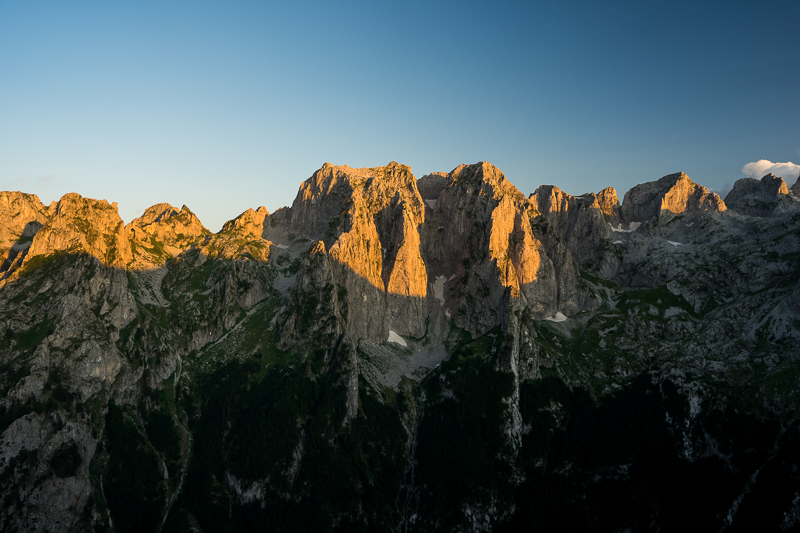


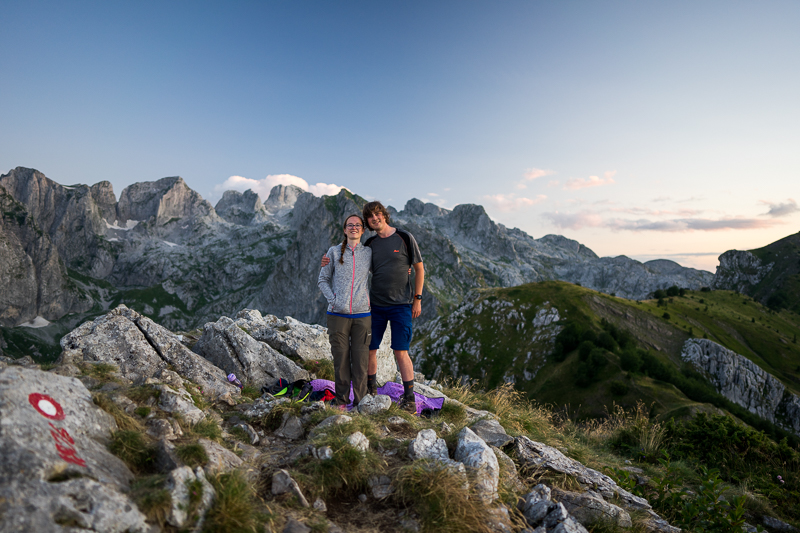
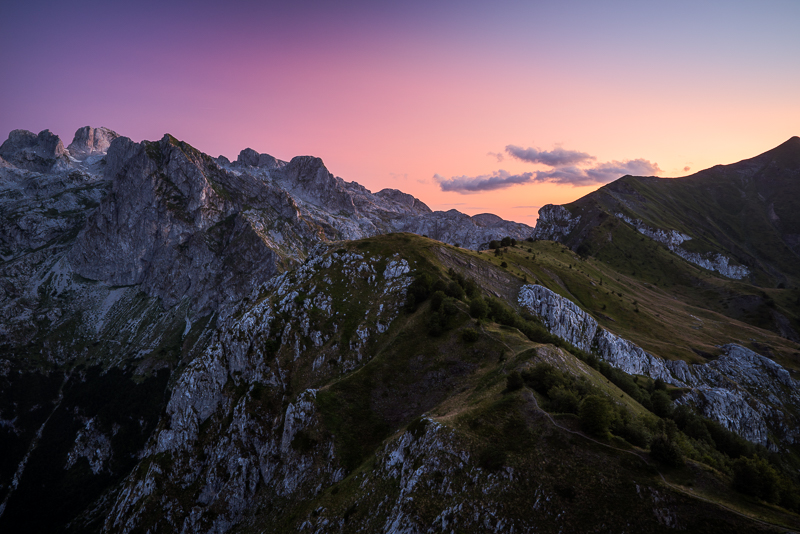
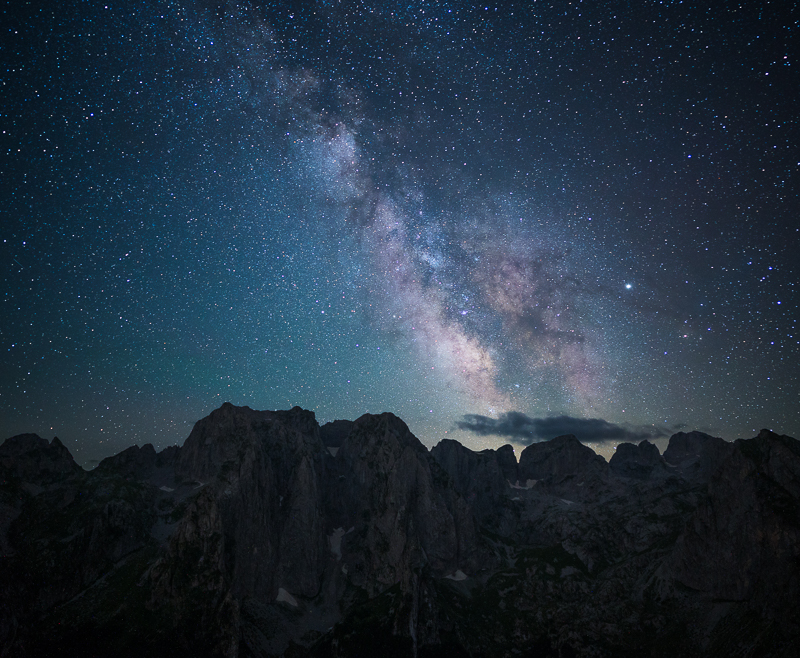
After taking the milkyway shot we went down the mountains with the help of our good head lights. A walk in the pitch dark is a very special experience and when you put out the headlights and you can’t see your own hand in frond of you, as we did in the forest, you realize how messed up Western Europe is regarding light pollution.
The next day we walked around a bit in the valley (it was way to hot for serious hiking!) which is a nice experience itself. Here one can still find traces of the war in the form of bullet shells.
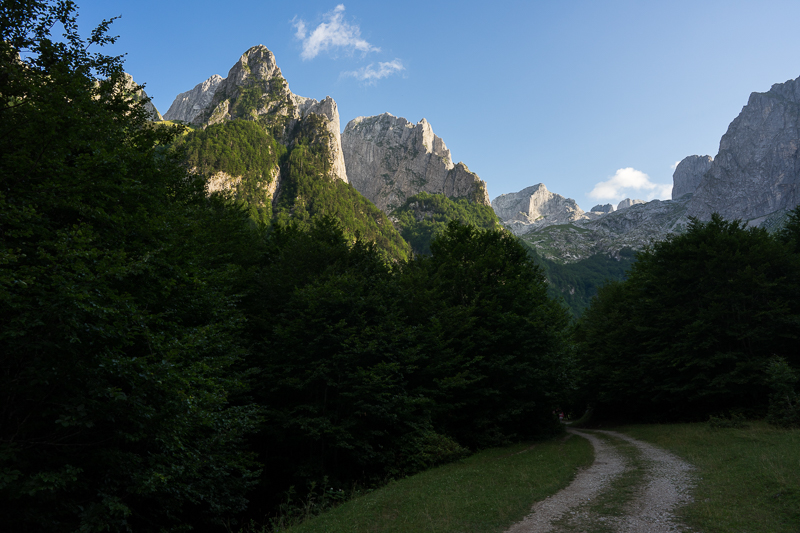
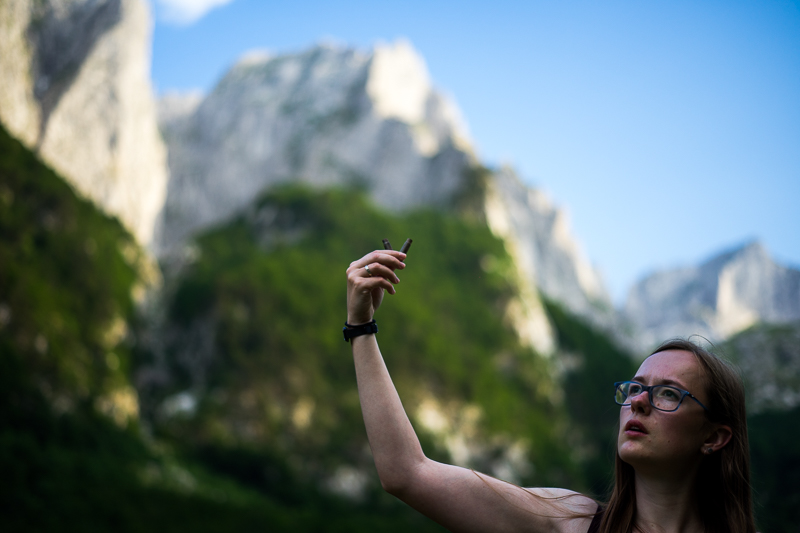
Later that week we drove Hridsko Jezero, a mountain lake near Plav at almost 2000 meter altitude. We were told that the road uphill was unpaved but in a very good state and that it was possible to go there with a “normal” car.
Well we managed to get up there but our Skoda Fabia was a bit too low. At some places the trail was deep and the plastic protection plate underneath our car took some serious hits.
If you have experience with off road driving and you car isn’t too low one could drive up to the lake. If you have no experience with off road driving it might be wise to not drive it yourselves.
The lake is very nice and certainly worth the long drive.
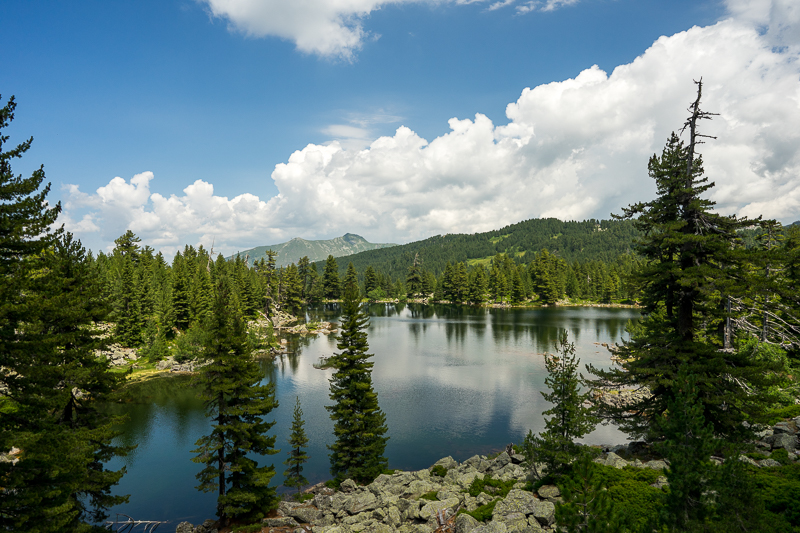
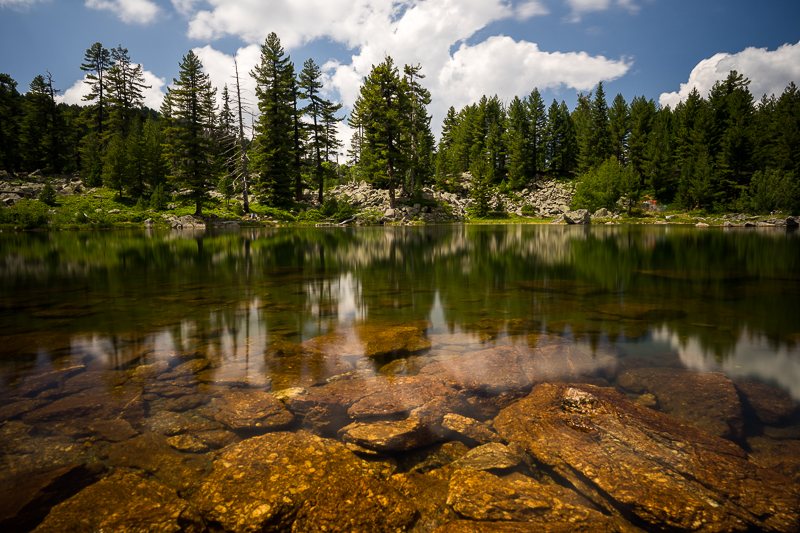
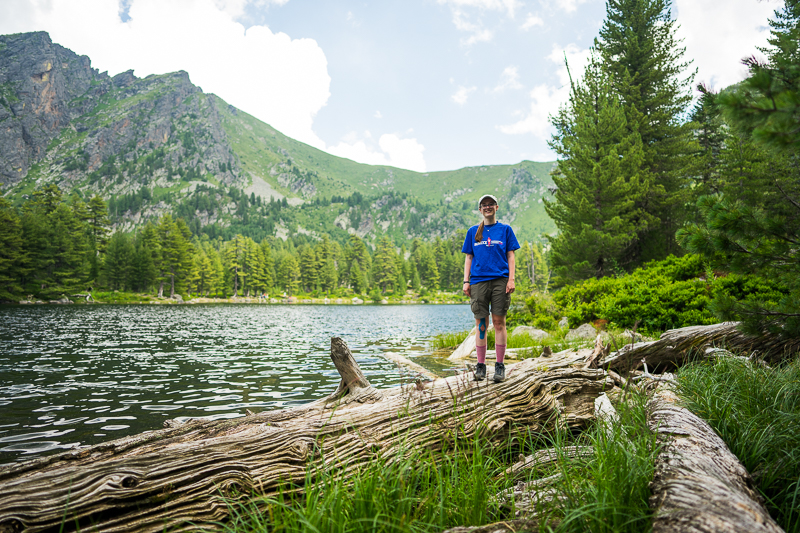
After a few nice days in Grebaje we continued our journey back to the coast. We drove to Budva via Albania. We passed the border with Albania near Vermosh and entered Montenegro again near Hani Hotit. This route is nicer, shorter and faster than the route via Montenegro only, and 95% of the roads are there for just a few years now and are in very good condition, but watch out for cattle on the road.
Budva
We stayed in a village next to Budva, Lastva Grbaljska. In theory it was only 10 minutes by car to get in Budva. Well, we were in a traffic jam for over 2 hours to find out that there was no parking space left anymore and the weather was terrible so usually it should be even busier.. So if you want to visit Budva make sure you stay in the town itself at a location with a private parking space!
We were very unlucky with the weather and had two days with rain and thunder. Only just before sunset at the second day we could see some sunlight. Later that evening I could even take a picture of the milkyway.
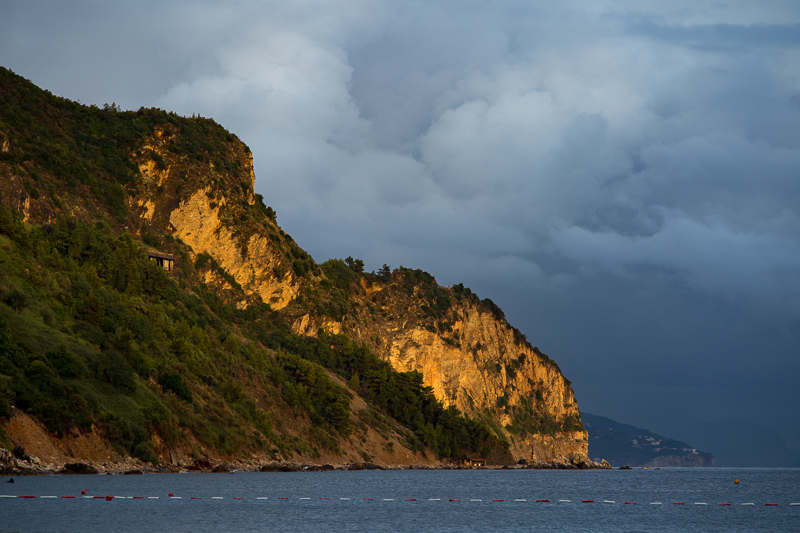
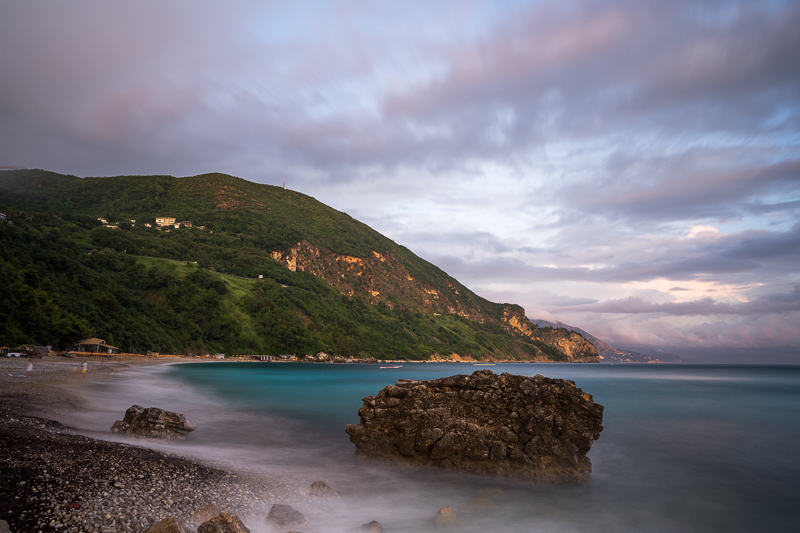
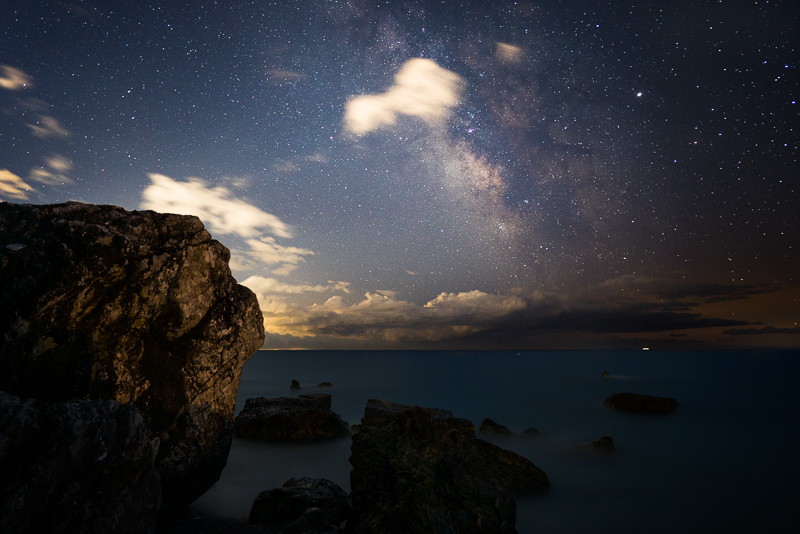
After two days in Budva we drove to Makarska, Croatia. We drove via Bosnia and Herzegovina and took the border crossing at Bileća.
Makarska
We only were in Makarska one afternoon and evening, nevertheless I can tell you a few spots that are interesting for photographers. Makarska is positioned at the foot of the Prirode mountain range directly at sea.
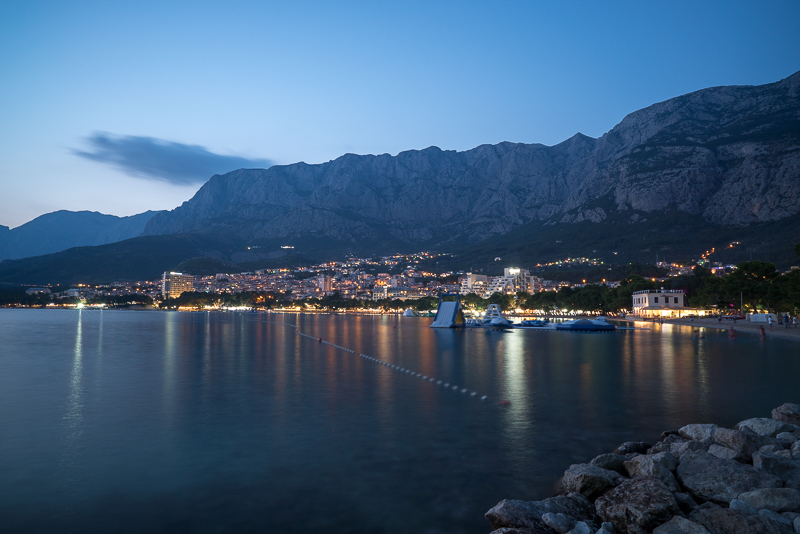
Makarska has a nice harbor with a boulevard and a nice market as well, around sunset and blue hour these are interesting subjects.
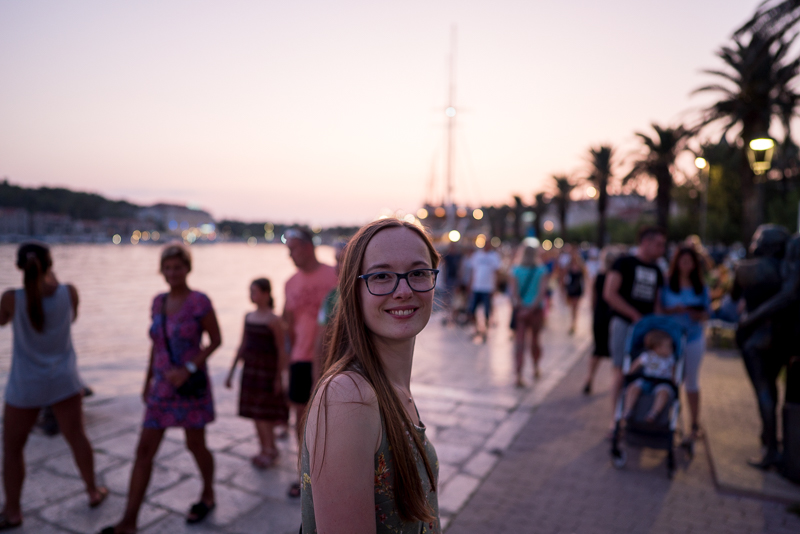
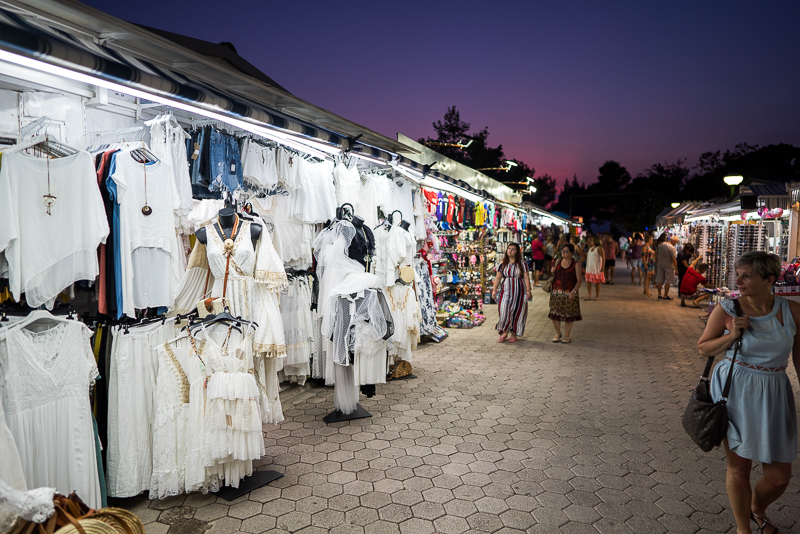
The beach and the harbor a divided by a small peninsula with a very small lighthouse on it. This was pretty nice during the blue hour.
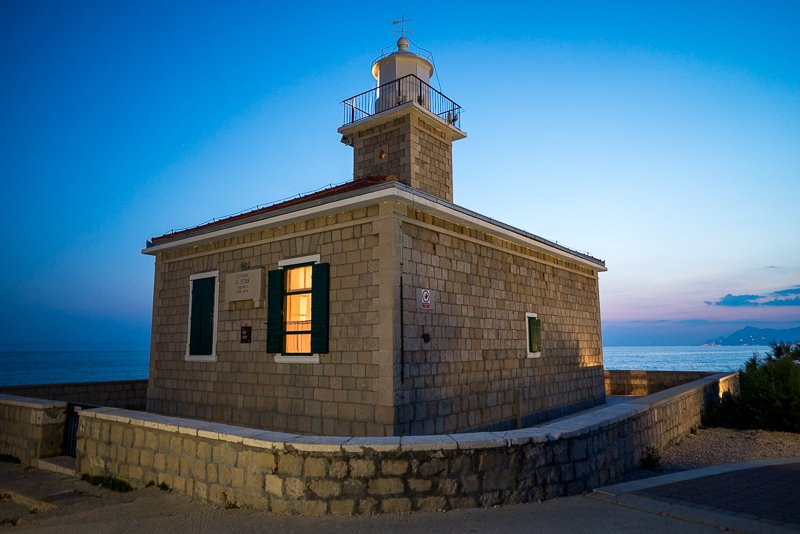
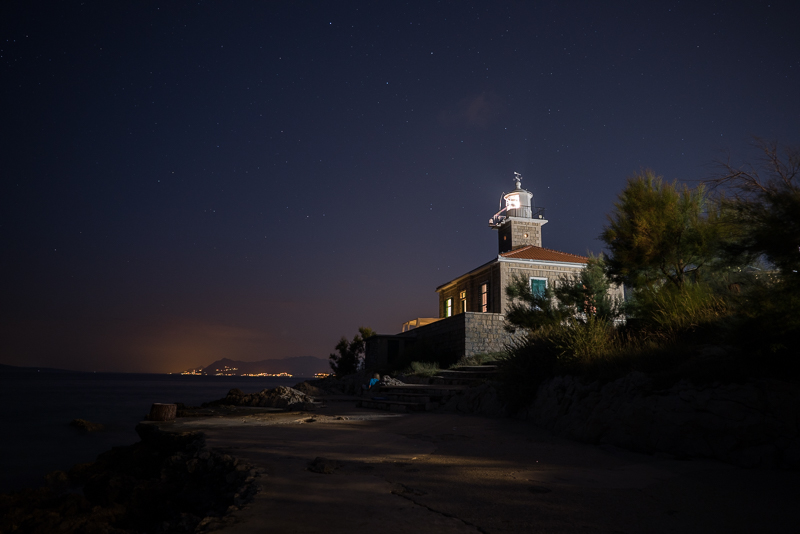
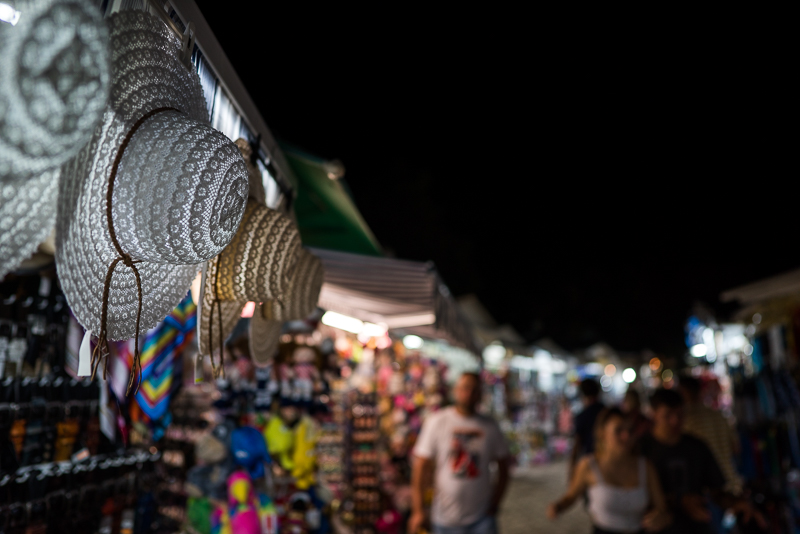
Austria
After our stay in Makarska we drove to Filzmoos, Austria with a stop somewhere in Slovenia. Since Austria is well known I will only share a few of my favorite pictures from there.
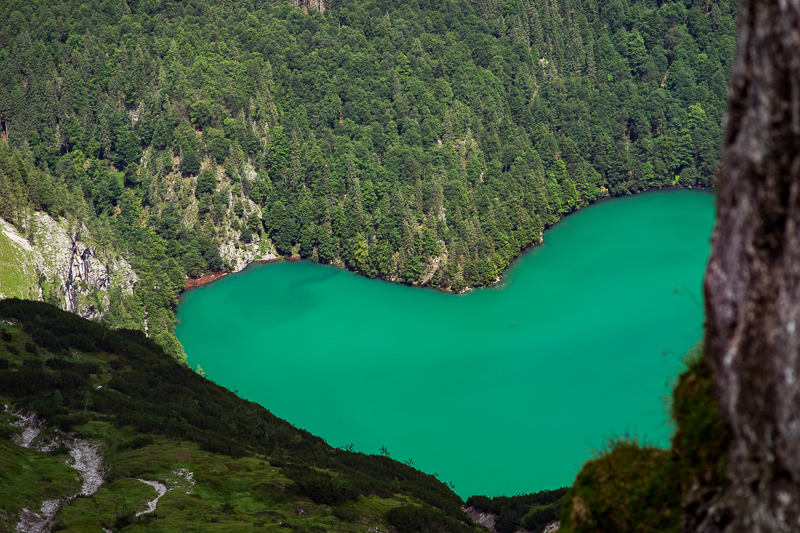
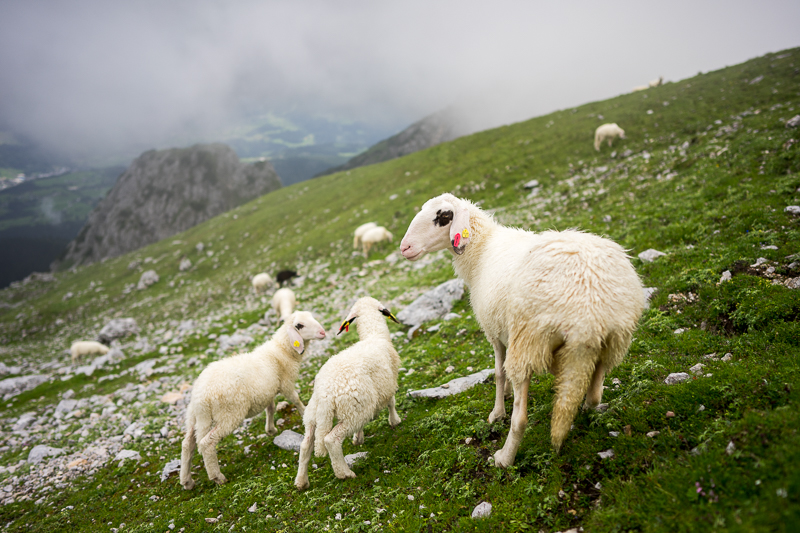
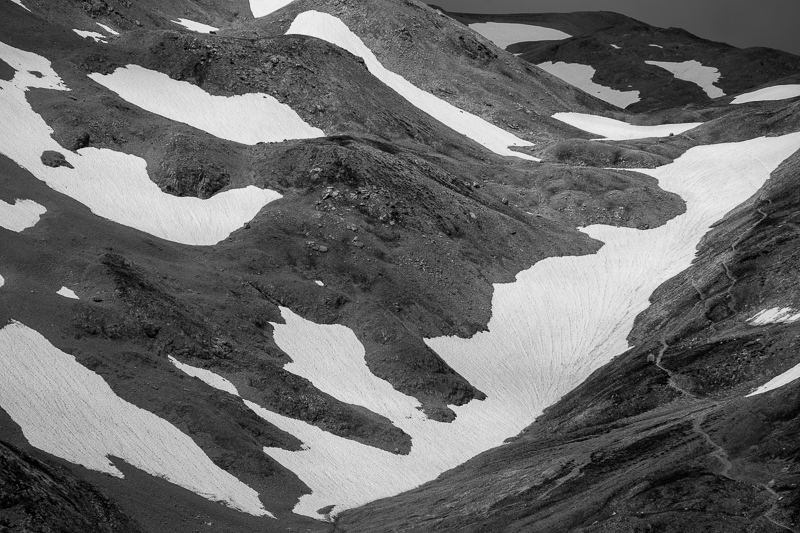
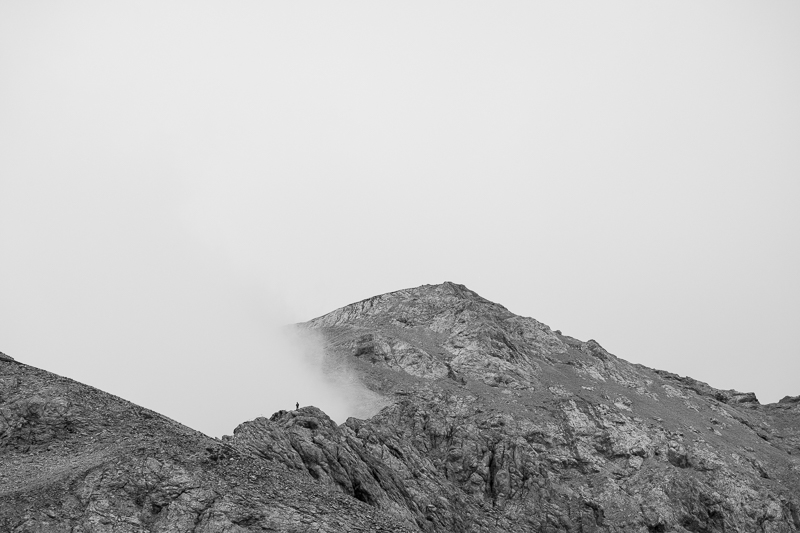
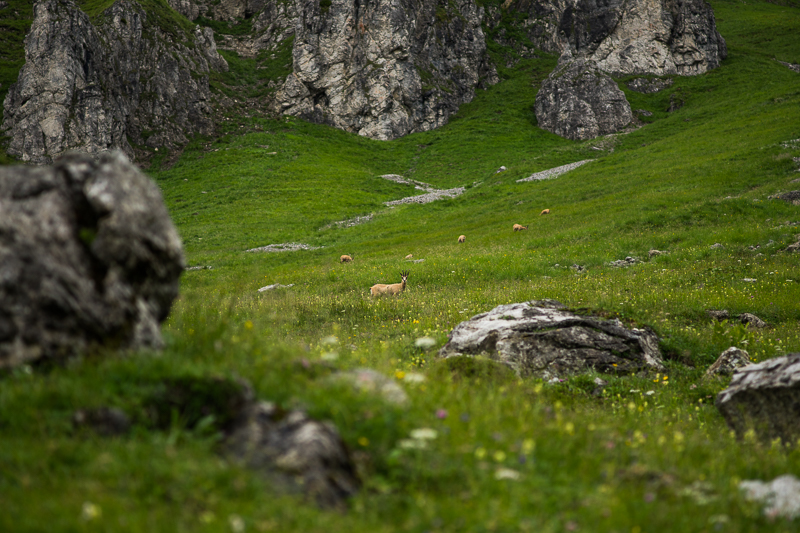
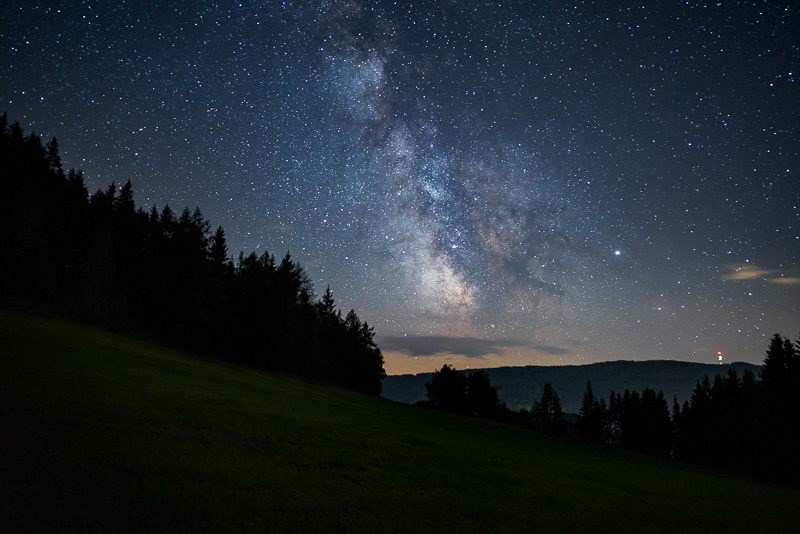
Highlights and conclusion
I liked our trip a lot but as can be expected there were some highlights. At first, I liked Mostar quite a bit, the touristic very old bazaar in the center and the broken buildings at the edges, how big can contrast be! I really made us feel grateful for the piece full life we have in the Netherlands.
The old city of Kotor was also very nice, I have not been in a town that was so nice to photograph before.
But for a biologist like me nothing comes close to the wild mountains of the Balkans with the Ledena Pecina ice cave and the sunset/milkyway high in the Prokletije mountains. Being all alone in that ice cold cave with the beautiful ice sculptures was awesome and it got me some unique pictures.
For me it was the fourth time I watched the sunset and milkyway from the Maja e Can and it was as magical as always. The play of shadows and soft light on the mountains across the valley is so cool to watch and of course to photograph. After that, one will be treated on the rise of the milky way during blue hour and the slow increase until it really shines against a pitch black sky full of stars.
For us so far no destination could beat the Balkans, but it certainly isn’t for everybody. Therefore I will quickly discuss what places are suitable for what kind of traveler. The old cities like Mostar, Kotor and Budva are quite modern, especially in the touristic center. The accommodations might be a bit less modern compared to what you find in the west of Europe, but they are very cheap and usually just fine and clean. The traffic can be pretty intense too.
Zabljak (Durmitor National park) is already for the more adventurous people. You need to drive quite a bit to get there, and to our experience accomodations we a bit more basic compared to e.g. Kotor. The most popular hiking routes are well maintained and relatively busy like in the Alps. The less popular routes are less good and you can walk here the whole day, only encountering a few people. For who loves nature and rest, can handle difficult trails and isn’t scared for a bit more basic (but very cheap) accomodations Durmitor is a great destination.
For the real adventurers and more experienced hikers Prokletije is an awesome destination. The last years we did several hikes without encountering anybody here. Except for a few popular routes tracks are marked lousy and the language of the markings was varying every kilometer. On earlier trips we needed our GPS device to keep track of the trail as it was barely possible to see where it was. For some great hikes and views I recommend staying at Katun Maja Karanfil in one of their bungalows. The bungalows are clean, the food at the restaurant is cheap and good and the staff is really kind and helpful. And on top of it, you have a great view from the accommodation and several hikes start in front of it.
In case you want to do stay in Vusanje, we had a good experience with Eco Katun Rosi there. The family also has a hotel in Gusinje, a nearby village but our experience there was much less good.
The food in the mountains consists mainly out of meat (Sheep, chicken, cow and pig) and cheese. If you are a vegetarian and you don’t like sheep cheese you will have a hard time there 😉
To be short, for photographers that like some adventure the Balkans are a great destination!
Conclusion about my gear
After a trip of almost 4 weeks I gained some insight in what worked for me, what I missed during my trip and what I didn’t need at all.
Camera’s
a7II: I used it for most of my images and it did not disappoint me. The IBIS was very helpfull for using my 135 mm lens without a tripod.
a7s: I was very glad I brought it. It really shined in the low light situations and is a light combination along with the GM24 to walk around with in the evening.
Lenses
Samyang 14 mm t3.1: I did not use this one at all, a panorama with the GM24 results in much better image quality.
Voigtländer 4.5/15: I used it only for a few shots where I needed the angle, and I was happy to have it there!
Sony GM 1.4/24: Most pictures of this trip were made with this lens. It is relatively light and small and because of it’s maximum aperture very versatile. I never had a lens like GM24 before and the amount of subject isolation in combination with the wide angle was a new experience for me.
For my landscape shots I also liked the angle of view, before I used to travel with a 15 mm and 50 mm which were always or too wide or too narrow, 24 mm felt like perfect! The speed, very good coma correction and excellent sharpness served my astro photography very well too.
Loxia 2/50: I only used this lens for a few shots but in the end I could have saved some weight by leaving it at home. Almost every shot I took could be taken with the Rokkor 2/55 as well.
7Artisans 1.1/50: I brought it and used it for a few portraits but in de end the Rokkor would have been fine too.
Canon newFD 3.5/135: I used it regularly whenever I needed a longer lens. It served me wel and I’m happy with the pictures I took with it. For the close future this will continue to be my tele option as it is a good trade off of size, speed and performance.
Other gear
I was glad I brought my ND and CPL filters, those are really tools. Check this article for more information.
During the trip I was pretty annoyed by my backpack and tripod.
At first my backpack: It is pretty comfortable and I can fit most of my gear in it. There is only one very big drawback, the access to my gear. To reach my my gear it is necessary to completely take the backpack off. This makes reaching your gear time consuming and at more difficult trails I didn’t even dare to do this which costed me some pictures. For my next big trip I will probably exchange this backpack for a Mindshift Gear rotation backpack. This backpack probably solves all problems I encountered with my Genesis Denali backpack green.
My tripod isn’t too stable, it’s ball head is hard to fix well and whenever a tiny bit of moister between the segments of the legs it seems to be impossible to move them. Oh and the glue of the rubber caps dissolves as well! Still, despite all annoying stuff this tripod did the job in the end, and I will save my money to replace it with a good one than rather than another piece of junk.
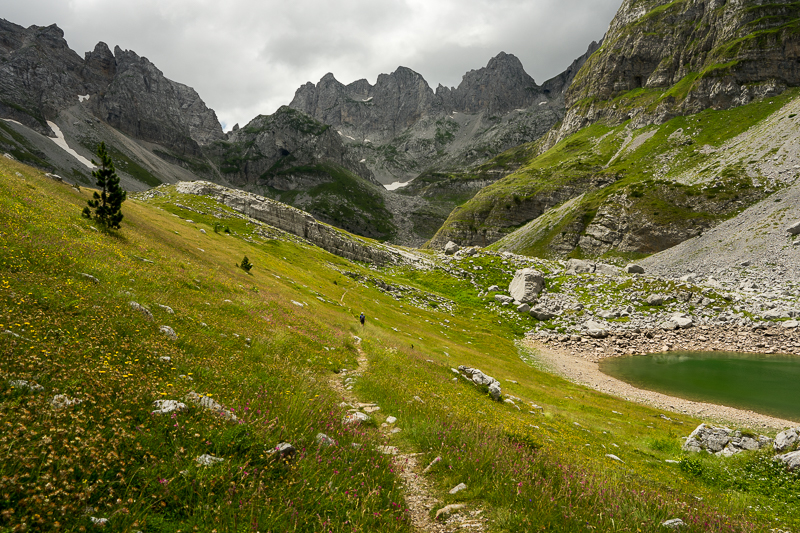
Further reading
- MADEIRA THROUGH THE EYES OF A PHOTOGRAPHER: TRAVEL-REPORT
- BEST ASTRO-PHOTOGRAPHY LENSES FOR THE SONY A7 SERIES
- BEST SONY FE LANDSCAPE LENSES FOR THE LIGHT TRAVELER AND HIKER
- WHAT WOULD WE TAKE INTO THE MOUNTAINS?
This site contains affiliate links. If you make a purchase using any of the links marked as affiliate links, I may receive a small commission at no additional cost to you. This helps support the creation of future content.
JuriaanM
Latest posts by JuriaanM (see all)
- Review: Sigma 85mm f/1.4 DG DN Art - January 8, 2022
- A beginners guide to landscape astro photography - March 11, 2021
- Canon newFD 50mm f/1.8: A review - January 4, 2021
Hi Juriaan, Well written article and great images. Would love to check out that part of the world. I saw you used the Sony 24 F1.14gm quite a bit. I use that lens quite a bit for travel. I wanted to ask you about the picture „Milkyway above the Karanfil range“. How many images did you take for this and was it difficult to combine them into Panorama? Did you have to use a star tracker for this image?
Hi MRK,
That picture is a panorama of 2 pictures in landscape orientation (f/1.6, ISO2000, 20 sec). I stitched those in Lightroom, which is very easy. I did not use a tracker, with the a7s ISO2000 usually is not much of a problem 🙂 I did take a serie to stack however, but I had no time to do this yet.
Happy you liked the 24 mm GM! I just returned my Tamron 17-28 mm as I was not happy with it, and decided to order the 24 mm GM instead. I like my Tamron 28-75 though.
Interesting you can do panoramas with the 24 mm! Do you know if one can put together panoramas with Capture One? Got my C1 in March.
I think of buying the GM 70-200 f2.8 next, do you think this is too big and heavy for travelling?
Were there any wind power plants in the Balkans? Norway is now becoming utterly destroyed as a landscape photography country because of hundreds of new wind power plants, most with German and international owners, like Google. So except for Lofoten our country is becoming sacrificed as Europe’s “green battery”. Sad, but true, and I don’t even want to travel through this savaged country either to get to Lofoten. So I might better make the Balkans my new destination for nature photography.
See a new documentary of the onslaught of the remnants of Norwegian nature here: https://tv.nrk.no/serie/valg-2019/2019/NNFA80002019
I think you will like the GM24, it’s a great lens with very nice rendering. I can’t help you with Capture One, I have no experience with that software.
Regarding the 70-200 f/2.8, it weighs almost 1500 grams, so for serious hiking I would not bring it. For that purpose I would rather get a 70-200 f/4 like for example the Canon which will save you 700 grams. For traveling in general like with a car the weight is less problematic.
In Croatia I have seen some wind power plants, and in Montenegro is know one spot with them. It really is a pity that they place them everywhere, in the Netherlands there are a lot of them too. I prefer solar energy 😉
Hi Juriaan,
thank you for sharing your travel experience with us. It’s a very detailed and honest report, i appreciate that.
You visited some stunning fotolocations, very inspiring indeed.
Funny (but not very surprising) to see the FD3.5/135 is actually delivering great results while being 60times cheaper than the 1.4/24GM, which obviously prodouces stunning images.
I’m surprised that you seem to accept its border/corner permance and CA when your other gear like the Loxia 50 and 24 GM is almost perfectly corrected glass.
The only things that really bother me on the FD3.5/135 are indeed the CA and low (micro)contrast. Sharpness is good wide open with very good corners but a midzone dip and it’s great at f/5.6. It is of course possible my sample is above average though.
I would like to update in the future nevertheless but good modern glass is very expensive, and the FD3.5/135 only costed me 3€ 🙂
24mm 1,4f is the ultimate lens to have 🙂 it fits almost everywhere 🙂
Lovely shots, Juriaan. The Buni i Jezerces, as with other images, shows what the 24/1.4 is capable of.
I’m used to taking panoramas with a 50mm 1.4 Nikkor but after seeing your work I’ll give my Voigtlander Ultron 28mm 1.9 a try.
Thank you! The 1.4/24 really is a versatile lens.
Hi Juriaan, may I find out from you on the ND filter you used on the Sony 24/1.4 GM?
I use the NiSi 75mm 10 stops ND filter, I like it quite a lot!
Thanks for your nice article!
I was thinking about the a7s. it is now very affordable, compared with the prizes it had some years ago. The question is, is it still better than mark iv at high ISO? In your opinion, is it worth to invest in it, or is better to preserve money to update a single body? Regards
I personally would not get the a7s instead your budget is really tight. The a7iii is more or less equally good and the a7riii isn’t too far of either, both offer IBIS and more resolution. Besides travelling with two bodies is quite annoying as I found out… Therefore I will probably buy an a7rIII when prices come down a bit more 🙂
Hi Juriaan, great work! What month did you travel in? Was surprised to see ice in Ledena Pecina but no snow outside
Thank you! We were there at June 22. On recent pictures I have seen there is much less ice now, however I heard every year a bit of the ice remains all way till winter 🙂
I’m asking myself if wider than 24mm is necesarry for travel photography. I’m planning on getting a 18mm in addition to my 24mm+ lenses, but I’m not sure I would use it much, because I feel like I can get every shot with 24mm, I just need to step a little back when I need wider shots or make panoramas (which end up looking great mostly in Lightroom classic & have high resolution). This article also shows that 24mm is wide enough most of the time.
Yes, i made some shots yesterday using 14mm samyang, but looking at them now it feels like the 14mm just has too much distortions. Wish I would have taken 24mm instead 🙂
For me making panorama’s with the 24mm would have been sufficient in most situations. I think 18mm might be a bit close to 24mm, doesn’t something wider make more sense in your kit?
Hi Juriaan,
best and most sympathic article since a long time, a lot of beautiful pictures. Congratulation from my side!
Hi Uwe, thank you for your kind words 🙂
Hi Juriaan,
Nice article. Actually, the oldest cities in Europe are located in the Balkans.
If I may point out something, as I also hike, try the Mindshift backpack before buying. The rotation feature is very nice, however you end up with your heaviest weight at the bottom of the pack. To date, the best I’ve found are chest packs.
Thanks for the tip!
Amazing photography job here! Well done!
Thank you!
Very good read and travelogue. Certainly good to see a new part of the world, thank you for sharing the stories and photos!
Thank you, you are welcome 🙂
Nice pictures. Now I can safely say 24 1.4 GM is just a perfect lens after reading this article.
Thank you very much for your essay: very beautiful photos, and a well-written report!
Your remarks about the gear are also useful. The Sony FE 24mm/1.4 GM really excels here. I am happy with my Loxia 21mm/2.8, but the GM has its own strengths thanks to the extreme speed of f/1.4. In addition, the Canon nFD 135mm/3.5 does a good job, too …
Thank you! For landscaping the Loxia is even better, more contrast, a bit sharper and better flare resistance 😉
Although the f/1.4 of the GM, it makes that lens simply very versatile.
i’ve read quite a few articles stating that a7s is not a still camera.
here’s one of them: https://www.dpreview.com/articles/5559775087/choosing-a-camera-should-i-worry-about-pixel-size
given the same sensor size and technology, generally the higher pixel count, the better iq, even at highest isos.
Now it doesn’t make much sense anymore to get the a7s for stills (unless you can get a used one very cheap and your budget is very tight). But back in 2014 when I got mine it was by quite some margin the best camera for milkyway photography… And it still is very capable for that task, also for landscapes in hgeneral as DR is great. Only resolution is lacking so one can’t crop much nor print large, but one can make great stills with the a7s 😉
Wow Jurriaan, I really enjoyed this article. Thank you for sharing these inspiring photos and story behind them. Because of you the 24/1.4 will enter my wishlist
Most people say that you don’t need bookeeeeh on wide angle lens. But that GM 24/1.4 looks soooo beautiful. It’s quite rare to see, mostly because nobody cares about it when considering wider lens. I think this is my next purchase!
24mm 1.4f lenses feature unique look, the bokeh and plane separation is really something only 24mm 1.4f can make. Although it is visible only from a certain distance no more than 2-3m from a person when you take a portrait. The results will be unique, but it also is a “one trick pony” in this regard, because you need to place your subject in the center due to distortions in corners, and you need to be close to get the best bokeh. Other than that, I would say the bokeh of these lenses resemble a medium format look. There is bokeh, but also there is just enough visibility in the far sight and the frame is very wide.
Nice trip! I have been thinking about getting the 24mm 1.4 for a while but I have the 28mm 2.0 and the 28-75 tamron. I know that one of these days I will give in and buy it!
Glad to see you went to Albania. I grew up there and go back once in a while and the place is really safe in general. Hope you had fun!
Hi Juriaan,
Really nice piece of reading combined with great photographs. I wish to see more content like this on the blog.
I see a lot of 24mm photographs.
Please help me.
My widest lens at the moment is FE 35/1.8 and I need wider solution to complement it.
I’m interested in landscape and documentary.
I gravitate towards 20/21, as 24 might be to narrow for hiking/landscape.
Did you get that feeling on this trip?
On the other hand, I’m afraid that 20/21 will be to wide for some documentary work.
I’m not talking lenses, I’m talking focal lengths.
Regards from Poland
Hi Alexander,
Thank you for your kind words!
It depends really on what your main focus is on.
Since you already have a fast 35 mm lens I personally would invest in a 21 mm lens as the gap in focal length is a bit bigger. A lens like the Loxia 2.8/21 is great for landscape photography, and the 1.8/35 would be a good option for your documentary work 🙂
Kind regards,
Juriaan
Thank you for your advice.
You might be right, 24mm won’t give me much as I have 35.
Loxia is an overkill for me tbh, performance and budget wise.
My landscape attempts are not that serious.
I am considering Skopar 21mm and Firin 20mm.
Firin would be good to try some astro at last, but CV will last longer and is smaller.
Take a look at this copy of Firin:
https://i.ebayimg.com/images/g/BvQAAOSwe2JdgKmb/s-l1600.jpg
And there is that hood..
I wonder what that new Tamron 20mm may bring to the table.
Kind regards,
Alex